172 SpazioItalia
OTTOBRE-DICEMBRE 2025 | OCTOBER-DECEMBER 2025


OTTOBRE-DICEMBRE 2025 | OCTOBER-DECEMBER 2025

The call of autumn

Siamo qui per aiutarti a vendere i tuoi prodotti e le tue idee attraverso storie emozionanti in grado di creare marchi straordinari. Contattaci per scoprire come valorizzare il tuo brand.
Vi do il mio più caloroso benvenuto a bordo di Air Dolomiti! Con l’inizio della stagione autunnale desidero condividere con voi alcuni importanti aggiornamenti e novità che ci accompagneranno nei prossimi mesi. Per l’anno 2025, avevamo individuato, come obiettivo prioritario, il miglioramento concreto di alcuni indicatori chiave come affidabilità, puntualità, che riteniamo strategici per il nostro settore e per i nostri passeggeri e che, negli ultimi anni, hanno registrato alcune criticità dovute a fattori eterogenei e in parte indipendenti dalla nostra volontà.
Tali parametri, a fronte di un grande lavoro, stanno mostrando segnali di ripresa. Non abbiamo ancora raggiunto i livelli ottimali a cui aspiriamo, ma la nostra continuità operativa e la puntualità dei voli aumentano con costanza e questi risultati rappresentano un importante passo avanti verso il pieno recupero delle nostre performance operative. Tale miglioramento è stato possibile grazie all’impegno costante dei nostri equipaggi e di tutti i colleghi dei reparti di terra: a pagina 5 trovate l’approfondimento sul “Progetto Maria”, un algoritmo predittivo sviluppato da una collega che, grazie al machine learning, contribuisce a prevedere e gestire i ritardi, migliorando l’efficienza operativa.
Inoltre desidero parlarvi di una importante evoluzione della compagnia: dopo anni di intensa espansione, il nostro sforzo oggi è volto a stabilizzare e consolidare i risultati raggiunti, senza mai perdere di vista lo sviluppo e la sinergia sempre più stretta con il Gruppo Lufthansa. Un esempio concreto di questo nuovo sviluppo è l’ampliamento dell’operatività oltre i tradizionali hub di Monaco di Baviera e Francoforte, con l’avvio di voli verso nuovi aeroporti del Gruppo, come ad esempio Vienna. Questo permetterà di offrire ai nostri passeggeri ulteriori destinazioni e maggiori opportunità di viaggio.
Vi ringrazio per la fiducia che continuate a riporre in noi e vi auguro una buona lettura!

A very warm welcome to you all on board Air Dolomiti today. Autumn brings some important updates and developments that will accompany our airline over the coming months. Our top priority in 2025 is to ensure a tangible improvement to certain key indicators such as reliability and punctuality, both strategic areas for our sector and passengers. These have been affected by a number of challenges in recent years involving an array of factors, some of which were beyond our
Steffen Harbarth CEO Air Dolomiti
control. We are delighted to report that thanks to the considerable efforts made, these indicators are now showing signs of recovery. We have not yet reached the optimal levels we aspire to, but our operational continuity and flight punctuality are steadily improving, and these results represent an important step forward towards fully restoring our operational performance. This positive performance is thanks to the tireless commitment of our crews and all our colleagues in the ground departments.
On page 5 you will find further details on the Maria Project, a predictive algorithm developed in house which uses machine learning to help us to anticipate and manage delays, thereby enhancing operational efficiency. I would also like to highlight a significant development within the company. After years of rapid expansion, our current focus is on stabilising and consolidating the results we have achieved, while never losing sight of further growth and the
increasingly close synergy with the Lufthansa Group. A concrete example of this new phase of development is the expansion of our operations beyond the traditional hubs of Munich and Frankfurt, with the launch of flights to new Group airports, such as Vienna. This means our passengers will benefit from additional destinations and greater travel opportunities.
Thank you for your loyalty in choosing Air Dolomiti and I hope you enjoy this edition of our magazine.
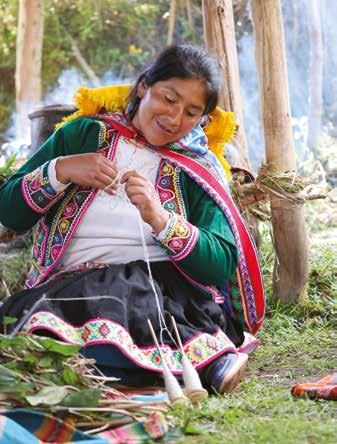
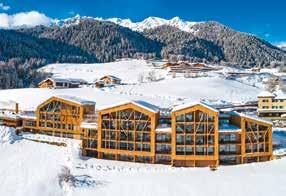

La puntualità nasce dal caos
Order from chaos 05
Se un giorno d’autunno un viaggiatore…
If on a autumn day a traveller… 08
Entra nella tua scomfort zone
Into the discomfort zone 12
Sandro Tiberi, il maestro dei cartai
Sandro Tiberi, master papermaker 19
Full immersion nel Bello
Immersive aesthetic experience 23
Tempo libero Free time
“Volare sulla neve è gioia e libertà"
“Flying through the snow is freedom and joy” 29
Voglio un autunno dolce!
Autumn sweet autumn 33
Val Ridanna, terra di whisky
Whisky galore in Val Ridanna 37

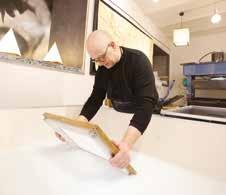
(amadei.spazioitalia@gmail.com)
Progetto grafico
Copertina / cover:
Tirolo (Bz), Castel Fontana ph ©RoterRucksack

Le rubriche
Cantina a bordo / Business Class cellar 42
Air News / Air News 43
Informazioni passeggeri / Passenger information 45
Uffici di conciliazione / Arbitration boards 47
dei testi, anche se curata con scrupolosa attenzione, non può comportare specifiche responsabilità per eventuali involontari errori o inesattezze. Ogni articolo firmato esprime esclusivamente il
Tutti diritti sono riservati. È vietata la riproduzione dell’opera o di parti di essa, con qualsiasi mezzo, compresa stampa, copia fotostatica, microfilm e memorizzazione elettronica, se non espressamente autorizzata dall’editore. Per quanto riguarda le immagini, l’editore è a disposizione degli aventi diritto con quali non è stato
Cosa c’entrano machine learning, big data e intelligenza artificiale con un imbarco in perfetto orario? Ce lo spiegano Caterina Alessi, matematica e data analyst di Air Dolomiti e il comandante Matteo Cecchin Order from chaos What links machine learning, big data and AI to perfect boarding times? Air Dolomiti mathematician and data analyst Caterina Alessi and Captain Matteo Cecchin reveal all
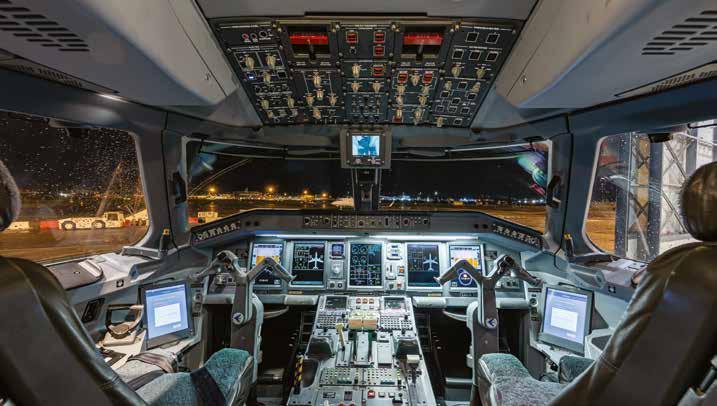
I matematici, al pari dei filosofi, hanno una visione del mondo diversa dagli altri esseri umani. Riescono infatti a vedere ordine dove ordine, a prima vista, non c’è, e trovano un fascino primigenio nel disordine, essenza rarissima in un mondo apparentemente sin troppo ordinato. Il lavoro di Caterina Alessi, una laurea magistrale in matematica con tesi dedicata al “machine learning” e alle sue applicazioni nella prevenzione dei ritardi nei voli aerei, va in questa direzione. La sua missione? Applicare la modellistica e l’intelligenza artificiale ad un fenomeno più vicino al caos che non all’ordine, ma che in realtà poggia su una base di fatti concreti e misurabili.
“Quando un aereo è in ritardo nessuno è mai felice e il fatto di poter mettere a disposizione dei passeggeri di Air Dolomiti l’intelligenza artificiale per prevenire questi disagi dà ai miei studi teorici una concretezza molto terrena.
by GIOVANNI DE LUCA
Mathematicians, like philosophers, see the world differently to ordinary mortals. They see order and patterns where no order is apparent, and chaos, a rara avis in a world apparently all too tidy, is their catnip. This is the thrust of the work on preventing flight delays being carried out by Caterina Alessi, whose thesis for her master’s degree in mathematics focused on machine learning.
Predictive models also assist flight crews in planning their day and managing shifts and rotations more effectively
Her mission? To bring mathematical modelling and AI to bear on a phenomenon apparently closer to chaos than order, but which is actually based on concrete, measurable facts. “Nobody is ever happy when a plane is delayed. The fact that Air Dolomiti can now offer its passengers artificial intelligence to help prevent these hitches gives my theoretical studies a very down-to-earth dimension. As a data analyst, I’ve been
Con il mio lavoro di data analyst sto lavorando da un paio di anni alla messa a punto di un modello predittivo che integri al suo interno le molteplici variabili che danno vita ad un ritardo, cercando di interagire su una macchina complessa come una compagnia aerea, agendo sulle quelle variabili su cui possiamo intervenire”.
Detta in altri termini, sul meteo avverso nemmeno Caterina può farci nulla, “ma, se sappiamo che in un determinato aeroporto, in un certo momento dell’anno e in una certa fascia oraria - spiega Alessi - ci può essere un problema di vento, magari possiamo intervenire sul “turnaround” e farlo diventare la chiave di volta per rendere più efficiente il tutto”. Con il termine “turnaround” riferito a un aereo si indica l’intervallo di tempo tra lo sbarco di un volo e la partenza del volo successivo con lo stesso aeromobile. In altre parole, è il ciclo di operazioni di preparazione dell’aereo per il prossimo volo, che include attività come la discesa e sbarco dei passeggeri, la pulizia e la sanificazione del velivolo, il rifornimento di carburante, nonché le ispezioni tecniche e la manutenzione di base. Il turnaround è un aspetto critico nella gestione di aeroporti e compagnie aeree, perché influisce sulla puntualità e sull’efficienza operativa.
“In Air Dolomiti – spiega Caterina - abbiamo voli tendenzialmente brevi e quindi un aeromobile dovrà fare più scali durante la giornata ed è per questo che un turnaround ottimale dell’aereo avrà un impatto positivo su tutti i passeggeri che voleranno su quell’apparecchio. E magari può essere strategico allungare di qualche minuto il turnaround se questo ci aiuta ad “incastrare” al meglio tutte le operazioni. Il modello predittivo che ho messo a punto si è allenato sui dati derivanti da più di 150mila voli Air Dolomiti, dei quali conosciamo il numero di passeggeri, il peso dei loro bagagli, il meteo, l’aeroporto di provenienza dell’aeromobile e quello di arrivo, oltre che un’infinità di altre informazioni.
working for a couple of years on fine-tuning a predictive model that integrates the many variables contributing to delays, in an effort to interact with a system as complex as an airline and work on those variables we can do something about.”
In other words, not even Caterina can do anything about bad weather, but as she explains, “if we know that at a certain airport, at a particular time of year and within a specific time window there might be a wind problem, then perhaps we can work on the turnaround, making it the pivotal point for achieving greater efficiency.”
Turnaround in airlinespeak means the interval between one flight’s landing and the departure of the next using the same plane. In other words, it is the full cycle of operations preparing the aircraft for its next journey: disembarkation of passengers, cleaning and sanitisation of the cabin, refuelling, technical checks and basic maintenance. Turnaround is a critical aspect of airline and airport management, as it directly affects punctuality and operational efficiency.
“At Air Dolomiti,” Caterina explains, “our flights are generally short, so each
aircraft makes several trips and stops each day. So, an optimal turnaround has a positive impact on every passenger flying on that plane. Sometimes it can even be strategic to extend the turnaround by a few minutes, if that helps us fit all the operations together more effectively. The predictive model I’ve developed has been trained on data from more than 150,000 Air Dolomiti flights, complete with passenger numbers, baggage weight, weather conditions, the aircraft’s departure and arrival airports, plus a host of other details. Machine learning allows us to process this big data and build predictive models that surpass any human capacity in reaching the same conclusions within a short time frame.”
“The benefits for us pilots are truly significant too,” explains Captain Matteo Cecchin, who oversees the development of the platform created by
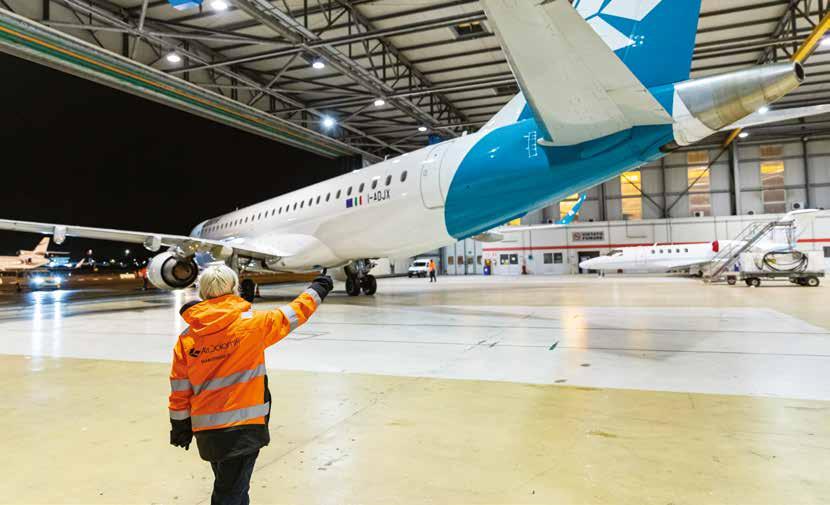
Impatto positivo I dati elaborati dal modello matematico aiutano anche nella programmazione delle manutenzioni ordinarie, in modo da poter ottimizzare i tempi in cui l’aeromobile resta fermo a terra
Positive impact
The data processed by the mathematical model also helps in scheduling routine maintenance, optimising the time an aircraft remains on the ground
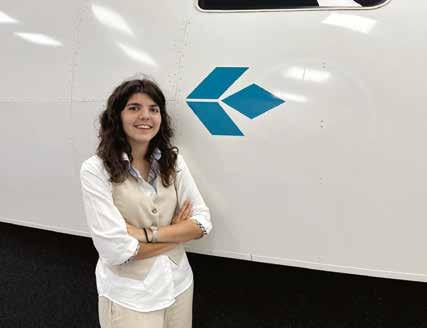
Il machine learning ci permette di digerire questi big data e di creare modelli predittivi che superano la capacità umana nell’arrivare in breve tempo alle stesse risultanze”.
“Anche per noi piloti - spiega il Comandante Matteo Cecchin, che coordina lo sviluppo della piattaforma creata da Caterina Alessi - i vantaggi sono davvero notevoli, al pari di quelli che hanno i passeggeri. E l’effetto concreto lo stiamo vedendo nell’aeroporto di Firenze, caratterizzato da una pista non troppo lunga e da un microclima con venti importanti, dove il modello previsionale di Air Dolomiti ci ha già permesso di ottimizzare gli imbarchi e ridurre i disagi per i passeggeri, con una finestra operativa che ci consente di prendere le decisioni tre ore prima del decollo. Nella consapevolezza che il modello apprende ogni giorno nuove informazioni e diventa sempre più affidabile”.
In questo modo il modello ha consentito di evitare migliaia di minuti di ritardo nell’attività della compagnia aerea, rendendo più fluida la giornata di ogni aeromobile e del suo equipaggio. Prossimo passo sarà quello di integrare anche la manutenzione per ottimizzare i tempi tecnici necessari per espletare questi interventi di routine e rendere tutto più efficiente.
“È un percorso che ad ogni passo si amplia - conclude Caterina - ti fa intravvedere nuove possibilità e ti invita ad esplorarle. E in una realtà complessa come una compagnia aerea, dove tutto è normato e gestito in nome della sicurezza, la sfida è ancora più affascinante”.
Sembra impossibile che la carriera di Caterina sia iniziata all’età di 5 anni, durante le partite a carte con la nonna Maria, prima che la giovane matematica si desse al Burraco. “La teoria del gioco è stata una parte importante anche della mia formazione universitaria e non a caso “Maria” è il nome che ho dato al modello predittivo sviluppato per Air Dolomiti”. Per cui, quando salirete perfettamente in orario sul prossimo volo Air Dolomiti, un pensiero vada anche a nonna Maria, perché, grazie alla sua influenza sulla nipote, il caos in cui oggi viviamo è sempre un po’ più ordinato rispetto a quello di ieri.
Data analyst
Caterina Alessi, la matematica al servizio del volo
Data analyst
Caterina Alessi, mathematics takes flight
Imbarchi puntuali
Un volo in orario nasce da una serie di procedure effettuate correttamente e nei tempi previsti, che coinvolgono non solo la compagnia aerea, ma anche la società che gestisce le operazioni in aeroporto
Onboard on schedule
An on-time flight depends on a series of procedures carried out correctly and within the scheduled timeframe, involving not only the airline but also the airport ground handling company

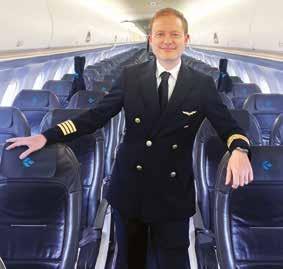
Decisioni complesse
Per Matteo Cecchin, Comandante Air Dolomiti, il modello elaborato da Caterina Alessi, è uno strumento in più per gestire al meglio i voli assegnati ad ogni pilota
Complex decisions
Air Dolomiti’s Captain Matteo Cecchin explains the model developed by Caterina Alessi is an additional tool to help manage the flights assigned to each pilot more effectively
Caterina Alessi, “just as they are for passengers. And we’re already seeing real results at Florence airport, which has a relatively short runway and a microclimate characterised by strong winds. Thanks to Air Dolomiti’s forecasting model, we’ve been able to optimise boarding and reduce inconvenience for passengers, with an operational window that lets us make decisions three hours before take-off. The model keeps learning new information every day and is becoming increasingly reliable.”
This approach has already saved the airline thousands of minutes in avoiding delays, making the working day smoother for each aircraft and its crew. The next step will be to integrate maintenance, optimising the technical time needed for routine checks and making the process even more efficient.
“It’s a journey that broadens our horizons with every step,” Caterina concludes. “Showing you tantalizing glimpses of new possibilities and inviting you to explore them. And in such a complex environment as an airline, where everything is regulated and managed in the name of safety, the challenge is all the more fascinating.”
It may seem hard to believe that Caterina’s career began at the age of five, during card games with her grandmother Maria, before the young mathematician took up the Canasta-style Rummy game Burraco.
“Game theory was an important part of my university studies too, and it’s no coincidence that I named the predictive model developed for Air Dolomiti ‘Maria’.”
So, when you board your next Air Dolomiti flight bang on time, spare a thought for Granny Maria. Thanks to her influence on her granddaughter, the chaos we live in today is getting a little more orderly than it was yesterday.
by GIULIA DE LUCA

Pausa tonificante a Tirolo - Dorf Tirol in tedesco - per scoprire il turismo calmo delle mezze stagioni If on an autumn day a traveller… Discovering the gentle tourism of the shoulder season in Dorf Tirol (Bz)
C’è chi ama la montagna per le camminate estive, le cime lontane, la fresca aria tra albero e albero; c’è chi la predilige in inverno, con le sue piste innevate, da percorrere tutte d’un fiato, verso il pranzo caldo in baita. Ancora in pochi, però, si fanno incantare dalla bellezza discreta, ma non per questo meno intensa, della montagna in autunno.
E chi pensa che passare un fine settimana autunnale in Alto Adige sia noioso, non potrebbe essere più nel torto. Si viaggia ad un ritmo più sereno ed in sintonia con la natura, che si sta preparando ad un tempo di quiete. Rallenta la vita, si dirada il turismo, ma l’accoglienza e la qualità dei servizi offerti continuano ad essere quelli di sempre, a prezzi meno sostenuti.
A meno di un’ora di auto da Bolzano, il paese di Tirolo è un punto strategico da cui iniziare l’esplorazione.
Appena fuori dal centro, la funivia Alta Muta porta in pochi minuti fino all’Hochmuth, posizione privilegiata da cui
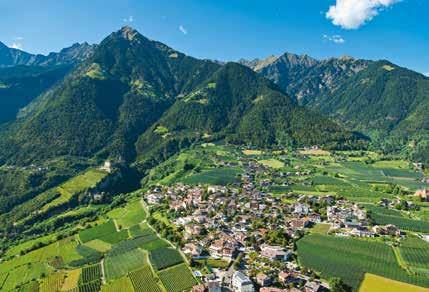
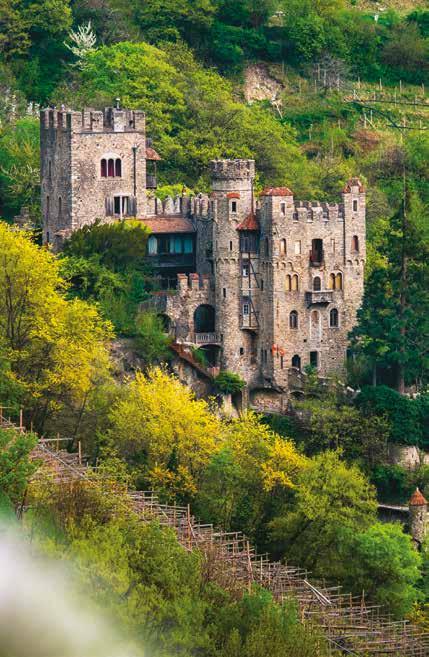
La natura chiama
Lo splendore di Tirolo nella mezza stagione, prima che inizi il foliage
The call of the wild Splendid Tirolo in autumn, just before the foliage season
Some people love the mountains in summer, revelling in hikes, distant peaks, and the refreshing shade under the trees, while others prefer them in winter, when you can skim down the snowy slopes to head for a piping hot lunch in a mountain chalet. Yet only a few connoisseurs fully appreciate the discreet, though no less intense, beauty of the mountains in autumn. But anyone who thinks that spending an autumn weekend in Alto Adige is boring is fair and far off. Admittedly things move at a calmer pace, slowing down in harmony with nature as it prepares for a period of respite. Life slows down, tourism thins out, but hospitality and the quality of services remain as high as ever—often at more affordable prices. Less than an hour’s drive from Bolzano, the village of Tirolo – or Dorf in Germanis a strategic point to begin
exploring from. Just outside the village centre, the Alta Muta cable car whisks visitors in a few minutes up to Hochmuth, a privileged vantage point from which to admire the peaks of the Texel Group and the first hints of autumn foliage along the Adige Valley. From here choose from hiking trails suitable for all levels, such as the Merano High Mountain Trail or the excursion to the Sopranes Lakes, while all the scattered mountain chalet Gasthaus are still open, offering warm hospitality and a tempting array of seasonal delicacies. If culture is more your thing, this is the perfect opportunity to visit two castles in the area: Castel Tirolo and Castel Fontana. Castel Tirol, which gives the area its name, was founded in the early 12th century and is today a symbol of the region’s history — a silent witness to the passage of time. Just a stone’s throw away, hidden in the fastness of an ancient forest,
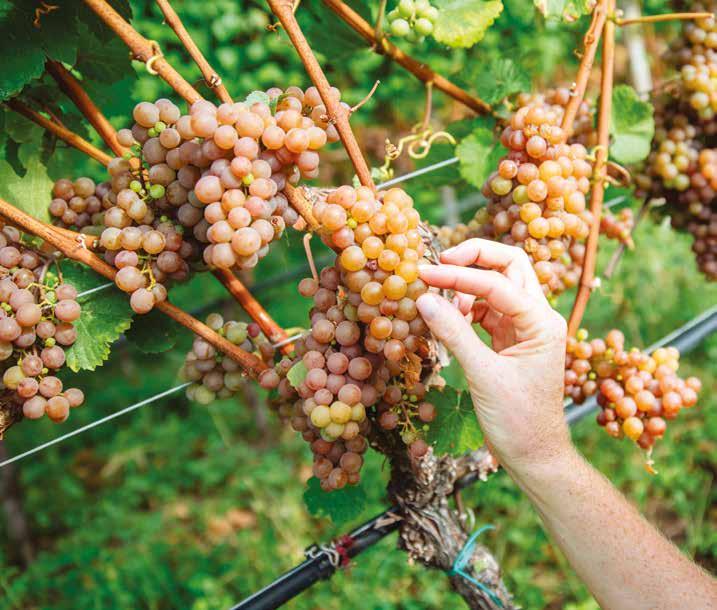
La strada del vino
Una passeggiata in tutto relax fra i vigneti della zona Wine walks
A relaxing stroll amidst the vineyards
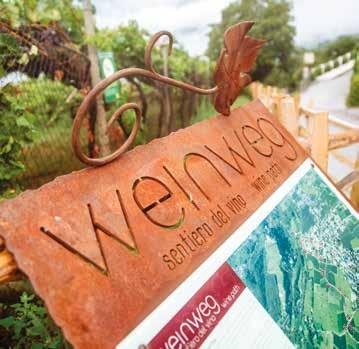
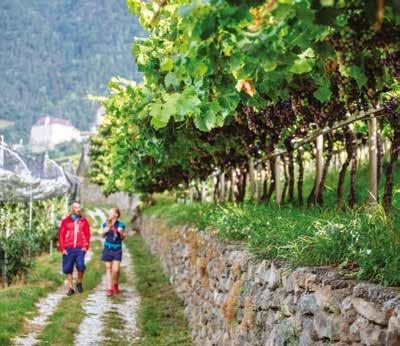
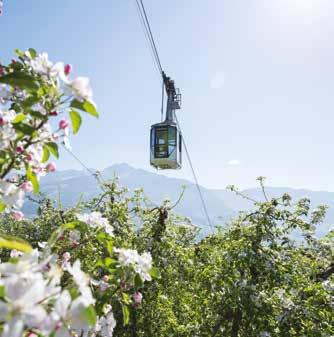
apprezzare le cime del gruppo del Tessa ed i primi sentori di foliage lungo la Valle dell’Adige. Da qui partono sentieri escursionistici “per tutti gli scarponi”, come l’Alta Via Meranese o la gita ai laghi di Sopranes, mentre le Gasthaus sono ancora aperte per tentare il turista con manicaretti stagionali.
Per chi ricerca un momento più culturale, l’occasione è propizia per visitare due dei castelli dell’area, Castel Tirolo e Castel Fontana. Il primo, che dà il nome alla zona e la cui fondazione risale agli inizi del XII secolo, è ad oggi simbolo della storia del territorio, testimone costante e silenzioso del tempo che scorre. A poca distanza, nascosto tra alberi secolari, Castel Fontana è, invece, sede del Museo agricolo dell’Alto Adige e funge da sfondo per eventi musicali (come il festival di Castelcello, rassegna dedicata al violoncello) e culturali. Non solo, il maniero è casa - nel vero senso della parola - dei membri della famiglia de Rachewiltz, discendenti del poeta statunitense Ezra Pound, che qui soggiornò per alcuni anni a metà del 1900. I de Rachewiltz sono anche esperti enologi, tanto da avere una propria piccola etichetta - Brunnenburg, dal nome in tedesco del Castello - con la quale hanno iniziato da qualche anno a sperimentare con le nuove frontiere della viticoltura, come i vini piwi, ovvero selezionati a partire da vitigni naturalmente resistenti alle malattie fungine. Montagna d’autunno significa anche passeggiate tra gli innumerevoli meleti che punteggiano i dintorni di Tirolo e che proprio in questa stagione sono carichi di frutti pronti per la raccolta.
E quando gli animi saranno stanchi di esplorare, autunno a Tirolo vuol dire sedersi insieme allo stesso tavolo per gustare il Törggelen, il tipico e abbondante pranzo altoatesino, che celebra la fine della pigiatura dell’uva. Si mangiano caldarroste, zuppa d’orzo, affettati, salsicce e pane rustico, innaffiando il tutto con abbondante vino novello. Questa usanza ha origini contadine secolari, e rappresenta una festa ed un ringraziamento alla natura per tutto ciò che ha donato durante l’estate appena terminata. Perché, in fondo, non importa la stagione, ma lo stare insieme e gioire di ciò che il territorio ha da offrire.
Montagna d’autunno, fidatevi, ne vale la pena.

Verso il
La funivia Alta Muta, ottima soluzione per apprezzare il panorama in quota e senza fatica, mentre lasciamo i sentieri alpini ai più sportivi
To infinity and beyond The Alta Muta cable car accesses stunning views, although the more athletic may appreciate climbing the mountain trails
Castel Fontana houses the South Tyrolean Agricultural Museum and provides a setting for musical and cultural events such as the “Castelcello” festival dedicated, as the name suggests, to the cello. The castle is also the home of the de Rachewiltz family, descendants of the American poet Ezra Pound, who stayed here for several years in the mid-20th century. The de Rachewiltz family are also expert winemakers, and under their boutique Brunnenburg label - the name of the castle in German – they have recently begun experimenting with the cutting-edge techniques of viticulture such as piwi wines, produced
Vademecum
Funivia/Cableway Alta Muta: www.seilbahn-hochmuth.it/ Tirolo: www.merano-suedtirol.it/it/tirolo.html
Castel Tirolo: www.schlosstirol.it/it/ Castel Fontana: www.brunnenburg.net/it/
from grape varieties naturally resistant to fungal diseases.
Autumn in the mountains also means strolls through the endless apple orchards surrounding Tirolo, laden with fruit ready for harvest at this time of year. And when the spirit wearies of exploring, autumn in Tirolo is time for the Törggelen, the hearty traditional South Tyrolean feast that celebrates the end of grape pressing. Guests gather round the table for roasted chestnuts, barley soup, cold cuts, sausages, and homemade bread, all washed down with generous amounts of the new wine. This centuries-old rural tradition is both a festival and a thanksgiving to nature for all its summer bounty, because when all is said and done, the season matters less than the joy of coming together to savour what the land has to offer and autumn in the mountains is well worth the effort.
by GIOVANNI DE LUCA
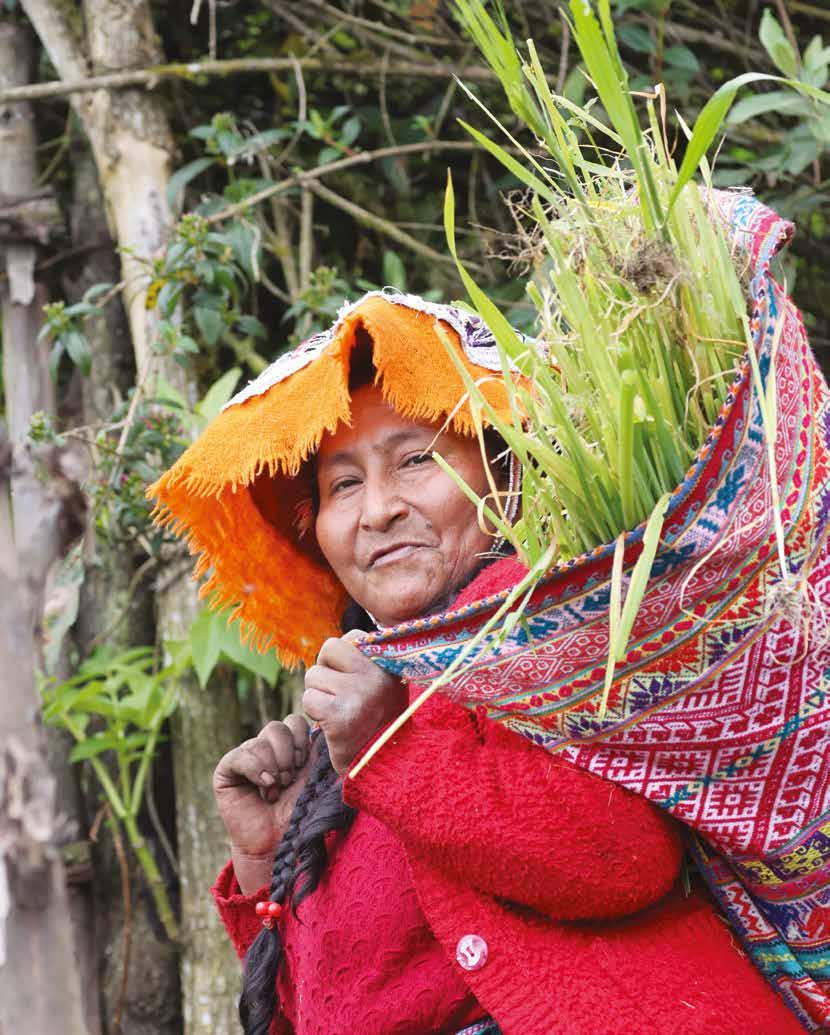
Ritmi andini
Nella comunità Quechua di Parobamba, nella valle del fiume Mapacho, dove mais e patate sono le colture principali
The rhythm of the Andes
In the Quechua community of Parobamba, in the valley of the Mapacho river, where corn and potatoes are the main crops
Da un progetto di vita ad un’idea da condividere con nuovi compagni di viaggio. Benvenuti nel mondo di Mattia Fiorentini e del suo turismo solidale di comunità Into the discomfort zone Welcome to the world of Mattia Fiorentini and what started as a life project before morphing into solidarity tourism to share with new travel companions
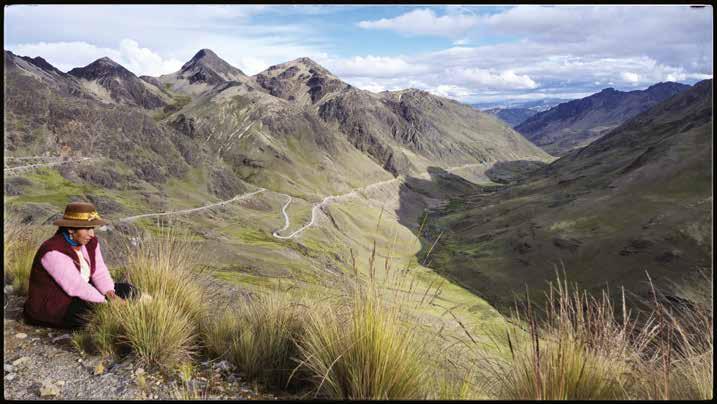
Ti
You might stop for a break and come across a woman sitting in the middle of nowhere. Obviously you offer her a lift
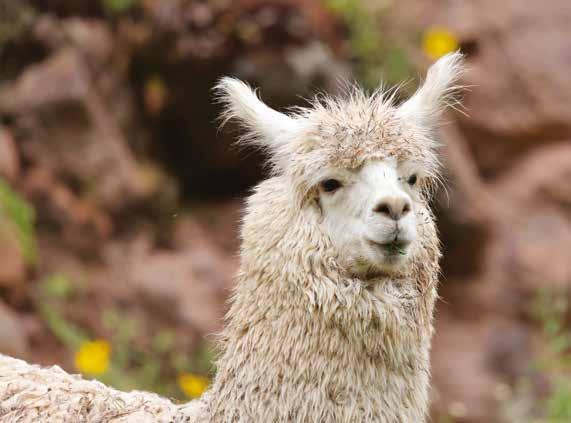
Difficile dire cosa volesse fare da grande, ma Mattia Fiorentini da Forlì la laurea in economia aziendale l’ha presa e, per la gioia dei suoi genitori, in breve tempo è riuscito anche ad entrare in un’importante realtà associativa dell’industria romagnola. Stipendio sicuro, lavoro in giacca e cravatta e orari compatibili con una vita senza troppe preoccupazioni. Poi arriva una
Camelidi andini Lama e alpaca, a loro abbiamo certamente causato molto “scomfort” inseguendoli per scattare qualche foto Andes fauna
We certainly caused the llamas and alpacas some discomfort pursuing them for a photo
Who knows what he actually dreamed of doing when he grew up, but Mattia Fiorentini from Forlì dutifully bagged a degree in business and economics and, to his parents’ delight,
then moved seamlessly into a large firm solidly embedded in the industrial profile of Italy’s Romagna region. Done and dusted. A safe desk job with a sensible work-life balance. But then came a radical overhaul of the company he worked for and the ruthless logic of “last in first out” saw a slew of newbies sacrificed to efficiency. Mattia ended up unemployed, transiting all too swiftly from his comfort zone to a far more edgy “discomfort” zone.
Never one to despair, Mattia decided the time was ripe for a tad of travel therapy.
His first stop was Seville, before being lured further afield by the siren call of South America, and heading off to Argentina via Ecuador, Chile and Colombia. It was Colombia that stole his heart, with that ineluctable sensation locals define as “buena onda”.
After roughly a year spent living with local communities, Indios and Amazon tribes in South America, Mattia returned to Italy and qualified as an
Manualità Filatura e tessitura della lana d’alpaca vengono ancora oggi effettuate seguendo le tecniche tradizionali della comunità
Craftwork Alpaca wool is still spun and woven using traditional methods

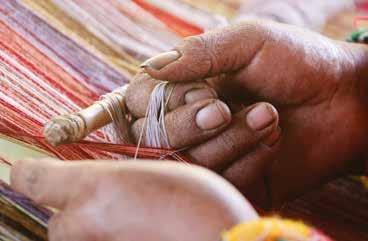
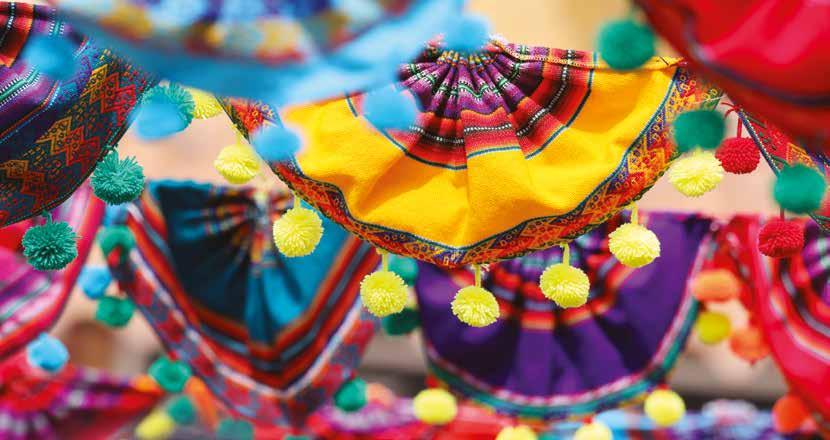
profonda ristrutturazione aziendale e gli ultimi assunti sono immolati sull’altare dell’efficienza: Mattia nel giro di qualche settimana si trova disoccupato, passando rapidamente dalla “comfort” alla “scomfort zone”. Abbacchiarsi? Non è nel suo Dna. Il rimedio migliore? Mettersi in viaggio.
Prima tappa Siviglia, poi il richiamo dell’America del Sud è stato troppo forte e Mattia si ritrova in direzione Argentina, con soste in Equador, Cile e Colombia. E qui scocca
Emozioni
Rapiti dai colori in un mercatino a Ollantayambo Emotions
Enchanted by the colours of a local market in Ollantayambo
environmental excursion guide, realizing that even travel experiences close to home in the Romagna Apennines could be turned into a profession. This was the start of Scomfort Zone® (www. scomfortzone.com), a project that wasn’t a traditional travel agency,
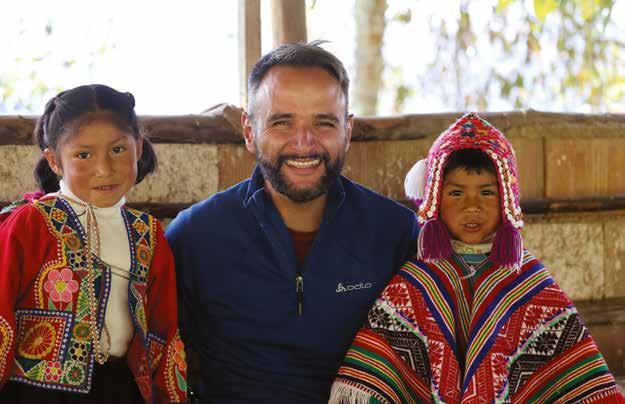
Vite scomfort
Mattia Fiorentini, da Forlì alle Ande Life of discomfort
Mattia Fiorentini, from Forlì to the Andes
but a workshop on sustainable tourism.
However, Romagna soon felt a little too homely after South America and Fiorentini launched international projects in three countries: Colombia, Peru and Madagascar. His tours might not be to everyone’s tastes, because Mattia takes his travelling companions to live an experience in local communities, with children and with native tribes. Not that the journeys are extreme, far from it, but you have to be prepared to put up with a certain amount of discomfort to see authentic realities and get your hands dirty to help sustain their development.
Forget about 5-star hotels (and 3- or 4-star hotels if it comes to that), because you’ll be living in people’s homes, in the middle of a forest, or in a tiny village in the Andes at an altitude of 3700 metres, three hours by jeep along a track to the nearest socalled town.
You eat with local families, living their lives – and you may well find yourself sharing a room with an enormous tarantula and having breakfast in a mud hut, eating toasted corn and drinking “mate” tea made from coca leaves and herbs. In Colombia Mattia supports a project for
Sentirsi piccoli Mentre
sei già 4700 metri di quota e vedi montagne altissime
Feeling small When you’re already at an altitude of 4700 metres and see more mountains towering above you
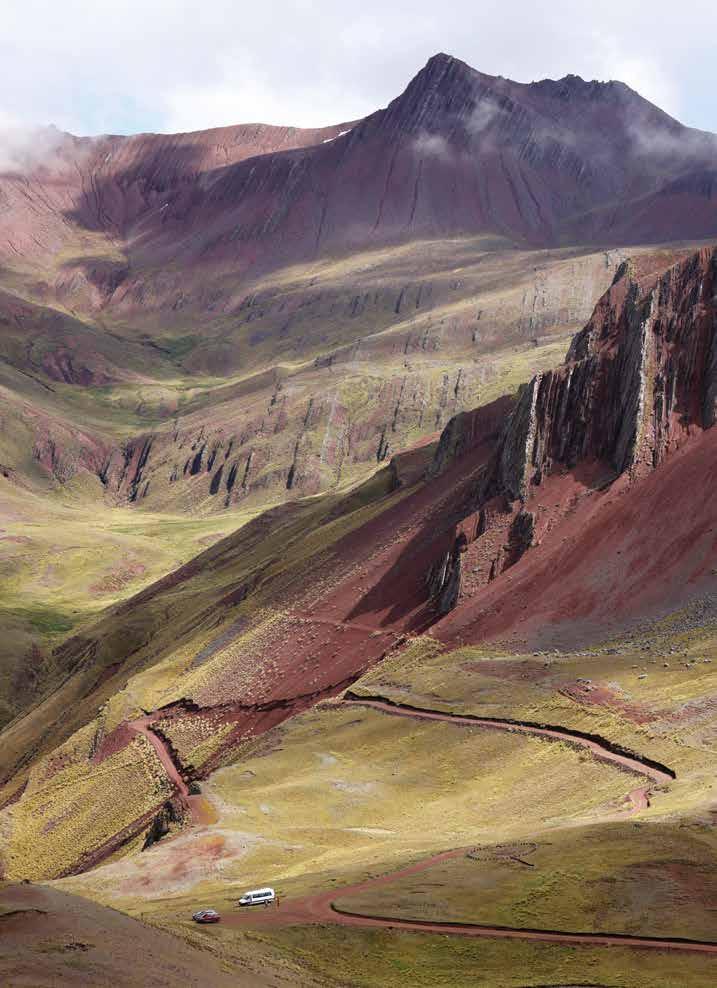
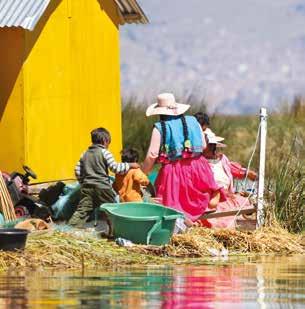
Sospesi nell’immensità
Sul lago Titicaca sulle isole galleggianti del popolo Uros, immerse in una luce a cui non siamo abituati Suspended in vastness
On the floating islands of the Uros people on Lake Titicaca, bathed in a light we are utterly unused
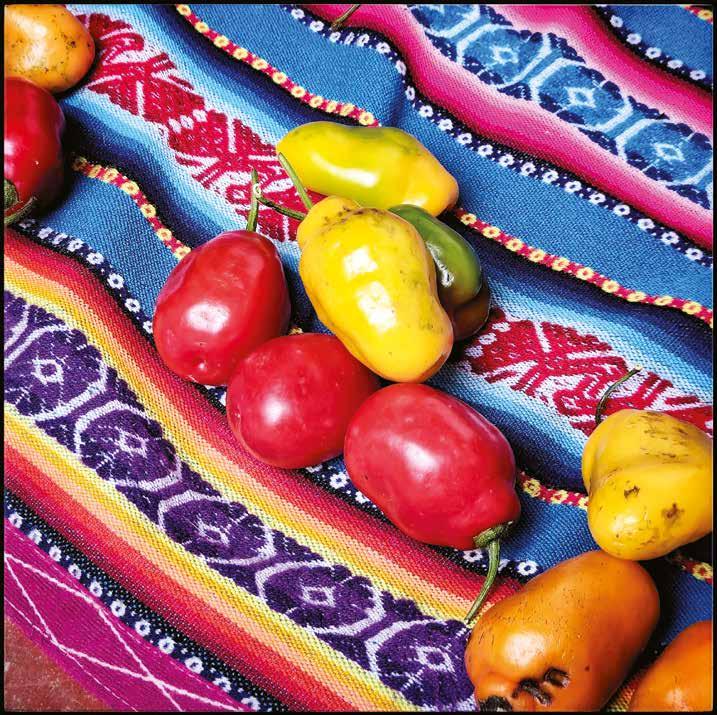
la scintilla con il paese latino americano all’insegna di quella che i locali chiamano “buena onda”. Parallelamente, rientrato in Italia dopo un annetto passato in mezzo a comunità locali, indios e popolazioni amazzoniche, Mattia diventa guida ambientale escursionistica e decide che il viaggio, anche se breve e sull’Appennino Romagnolo, poteva diventare un lavoro.
Nasce così Scomfort Zone® (www.scomfortzone.com) progett che non è un’agenzia viaggi, ma un laboratorio di turismo sostenibile. Ma, dopo il Sudamerica, la Romagna va stretta a Fiorentini e iniziano i progetti internazionali in tre Paesi: Colombia, Perù e Madagascar. Le proposte di viaggio non sono sempre facili da digerire, perché Mattia porta i suoi compagni di avventura a vivere esperienza in mezzo alle comunità locali, ai bambini, agli indigeni. Ma non sono nemmeno viaggi estremi, basta solo accettare un po’ di scomodità per vedere realtà autentiche e sostenere direttamente il loro sviluppo.
Il sapore dell’Aji
Il peperoncino piccante e super aromatico, ingrediente chiave del ceviche, piatto iconico della cucina peruviana
A touch of Aji
The flavourful - and fearsomely spicy - chili peppers which are a key ingredient of ceviche, Peru’s national dish
the poorest street urchins of Medellin, where they play football in a decidedly “scomfort” team, while in Madagascar other projects support the “Aid4Mada” charity, and visitors live with the children assisted by the project for a few days.
In Peru the most striking experience is a chance to spend three days with a Quechua community who breed alpacas, spinning their wool and weaving by hand according to ancient traditions. This is under
the aegis of the Canadian charity “Mosqui”, which sells their products all over the world.
The temptation to join Mattia on one of his journeys to the Andes was irresistible and took us to an altitude of 4800 metres where the mountains glowed in a kaleidoscope of fantastic colours.
These trips are tough, not physically because logistics are impeccable, but more on an interior level, because you discover your
Scordatevi gli alberghi 5 stelle (e anche quelli a 4 e 3 stelle), perché si vive spesso a casa della gente, in mezzo alla foresta o in paesini andini a 3700 metri di quota, a tre ore di jeep e di strada sterrata dal sedicente centro abitato più vicino.
Si mangia con le famiglie locali, si vive la loro stessa vita e si deve mettere in conto di poter condividere la propria camera con una tarantola grande come una mano o di fare colazione in una capanna di terra battuta, mangiando semi di mais tostati e bevendo “mate” (infuso) di coca e erbe aromatiche. In Colombia Mattia sostiene un progetto che coinvolge i ragazzi di strada di Medellin e permette loro di giocare a calcio in una squadra molto “scomfort”, in Madagascar ci sono altri progetti per sostenere le attività della onlus “Aid4Mada” e si vive per qualche giorno in mezzo ai bambini assistiti dal progetto. In Perù l’esperienza più forte è quella di passare tre giorni in una comunità Quechua che alleva alpaca, fila il loro vello e tesse a mano secondo le antiche tradizioni, seguita da “Mosqui”, una onlus canadese, che poi ne vende i manufatti in tutto il mondo.
Troppo interessante per non seguire Mattia in questo viaggio a ritmo andino, che ci porterà sino a 4.800 metri di quota a scoprire montagne dai colori fantastici. Sono viaggi impegnativi, non tanto fisicamente perché la logistica è curata perfettamente, quanto interiormente perché qui si tratta di conoscere un luogo attraverso le persone che lo abitano e con i loro tempi, molto lontani dai nostri. Senza lo stress di dover vedere tutto, senza poi portarsi a casa nulla.
Nel viaggio in Perù il vero disagio è essere permeati dalla cosmovisione andina, passare una giornata di cammino con un indigeno, il señor Salinas, laureato in archeologia a Lima, ma uomo di cultura quechua, che ti mette al centro di riti secolari, ai quali da bravo occidentale reagisci con perplessità, ma che dentro ti smuovono energie che non sai nemmeno di avere.
Brutta roba entrare nella Scomfort Zone, viaggiare con gente mai conosciuta prima, ballare la salsa in un mercato di Lima con dei perfetti sconosciuti o vivere con persone che parlano solo la lingua Quechua e che lo spagnolo lo sanno come te che non lo hai mai studiato.
Brutta roba perché torni a casa con una maledetta voglia di ripartire e ti metti a ridere con Mattia, quando ricorda i suoi (ormai improbabili) trascorsi confindustriali in giacca e cravatta.
destination through its native inhabitants and with their times and rhythms, so different from our own. There is no stress and no rush to “see” everything and you bring nothing back home with you.
During the trip to Peru the edge comes from being permeated by the cosmovision of the Andes as you pass a day trekking with Señor Salinas. Salinas graduated in archaeology

from Lima University, but he is first and foremost a Quechua, who places his charges at the centre point of centuries-old rituals, which may leave westerners perplexed, but also leaves them charged with unsuspected energy. Getting into the Scomfort Zone is decidedly discomfiting; you’re travelling with people you’ve never met before, dancing salsa in a market
in Lima with complete strangers or living with people who only speak Quechua and whose Spanish is on a par with your own ten words. Discomfiting because you come back home with a longing to set off again as soon as possible and you have a laugh with Mattia when he harks back to those long-gone days when he was a nine-to-fiver in a suit.
Il señor Salinas, indio, archeologo, musicista e sciamano: un pozzo di cultura andina Cosmo-vision
Señor Salinas, Quechua, archaeologist, musician and shaman: a well of Andean culture
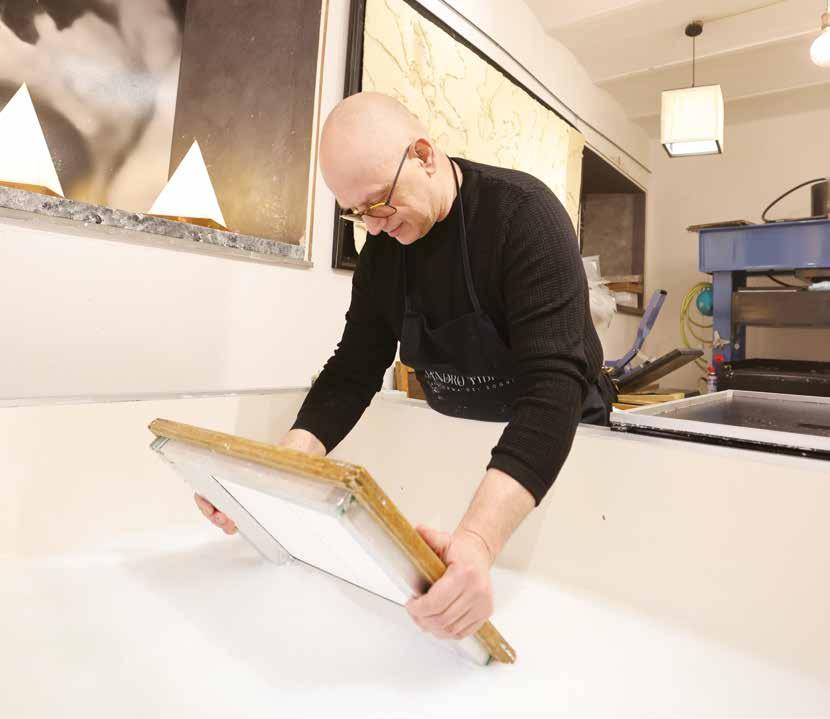
by GIOVANNI DE LUCA
Nel cuore di Fabriano (An), per scoprire l’arte di produrre carta a mano e per stupirsi della sua antica bellezza Sandro Tiberi, master papermaker We visit the town of Fabriano in the Italian Marche region to explore the stunning ancient art of artisanal papermaking
Sandro Tiberi è uno degli ultimi mastri cartai d’Italia, un artista e un tecnico di altissimo livello. Ma come i “grandi” non ha segreti e la sua vita oggi è rivolta alla divulgazione e alla formazione dei giovani per evitare che questa arte antica rischi di perdersi e per questo insegna tecnologia della carta all’Accademia delle Belle Arti di Roma.
La bottega in cui Sandro e sua moglie Gilvana Maria portano avanti il loro sapere è nel cuore di Fabriano, pochi metri quadrati nel centro storico, a vista sulla strada. Tutti possono entrare e tutti verranno accolti con cordialità, anche se in pochi si rendono conto di chi hanno davanti. Ma Sandro è innamorato della carta e potrebbe parlare per ore della sua grande passione, che per anni è stata principalmente professione come responsabile del settore delle “carte speciali” all’interno della cartiera di Fabriano, ma che oggi ha virato nettamente verso l’arte, cambiando letteralmente dimensione.
Il viaggio della carta inizia attorno all’anno 100 in Cina, dove era prodotta partendo da paglia di tè o di riso o canna di bambù, tesi suffragata dal ritrovamento di mappe, scritte su carta, risalenti al primo secolo. Poi, verso il 750, durante una spedizione militare, il governatore generale del Califfato di Bagdad catturò a Samarcanda due maestri cartai cinesi grazie ai quali questa tecnica venne poi resa disponibile nei Paesi del medio oriente. Rapidamente la produzione si diffuse anche in Egitto verso il 900, per raggiungere il Marocco attorno al 1100, per poi arrivare rapidamente in Spagna.
Fabriano è entrata a contatto con la carta a metà del XIII secolo, come testimoniano i primi documenti ufficiali
Mani d’oro Una delle filigrane “cucite” sul telaio da Gilvana Maria, lavoro delicatissimo e di estrema precisione
Skilled hands
A filigree watermark woven on screen by Gilvana Maria, a task requiring endless delicacy and extreme precision
Artisti
Sandro Tiberi e sua moglie, la brasiliana Gilvana Maria
Artists
Sandro Tiberi and his Brazilian wife Gilvana Maria

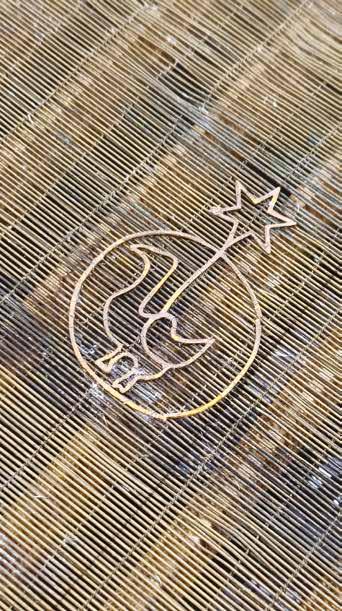
Sandro Tiberi is one of Italy’s last master papermakers, combining art and technique at the highest levels. And like all true great masters he has no secrets, devoting his life to sharing his knowledge and training young people to prevent this ancient art from being lost on his Paper Technology course at the Academy of Fine Arts in Rome.
Sandro and his wife Gilvana Maria’s rather snug workshop lies in the heart of the historic centre of Fabriano, open to the street and open for anyone to wander in and be warmly welcomed, even if few realise who they are dealing with.
Sandro is totally
passionate about paper and can chat quite happily for hours about his favourite subject.
After a long career as head of the “special papers” department at the Fabriano paper mill, today he has pivoted decisively towards papermaking for the art world, a different dimension of the field.
The history of paper goes back to around the year 100 CE in China, where it was initially produced using tea straw, rice straw or bamboo cane. This theory is supported by the discovery of maps written on paper dating back to the first century. Then, around 750 CE,
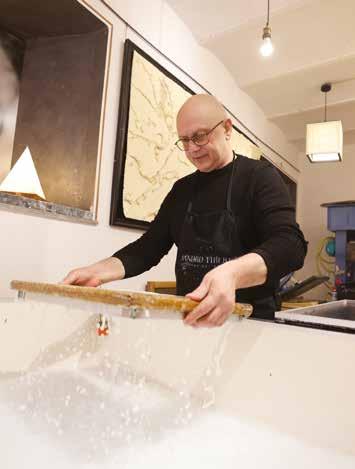

Tiratura limitata Pochi fogli all’ora, per un pubblico che sa apprezzare la mano del maestro Limited edition A mere handful of sheets are completed per hour, for a discerning public who know how to appreciate the work of a master craftsman
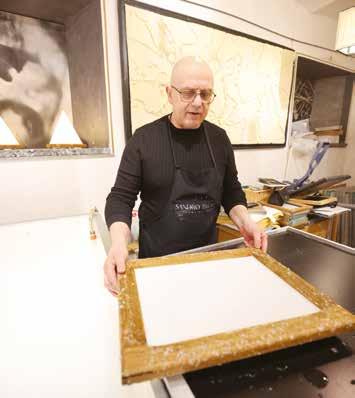


datati nel 1264, forse grazie a scambi commerciali con i produttori siriani, ma questo aspetto è ancora non chiaro.
“Le Marche – spiega Tiberi – sono poi diventate il luogo perfetto per dare alla tecnica allora in auge una nuova vita, perfezionandola e assicurando alla nostra città un predominio assoluto in Europa per almeno due secoli, grazie anche all’invenzione della filigrana, cioè del disegno o del motivo inciso o impresso all’interno della stessa fibra della carta durante il processo di fabbricazione”.
Una sorta di marchio di fabbrica che indicava la provenienza del prezioso manufatto.
Oggi come nel XIII secolo Sandro produce le sue carte con la stessa tecnica, immerge il telaio nel “tino” in cui viene messa in sospensione la “pasta” prodotta con fibre naturali, ne estrare una determinata quantità affidandosi alla propria esperienza, la stende sul telaio con movimenti scolpiti nei secoli e deposita il tutto con la massima delicatezza su quello che un tempo era feltro di lana. Poi il tutto viene messo in un torchio per eliminare l’acqua in eccesso e rendere la carta appendibile per proseguire con l’asciugamento.
In bottega Sandro è il maestro della carta, mentre Gilvana Maria è diventata un’abile “tessitrice” di filigrane, oltre che produrre una serie di borse realizzate al 100% con carta lavorata in maniera particolare.
Le carte di Sandro sono destinate al mondo dell’arte, ma non solo visto che il maestro ha iniziato una produzione di carte per l’arredo e oggetti per l’interior design, senza mai abbandonare i progetti più squisitamente artistici. Ma, da vero divulgatore, ha anche creato una cartiera itinerante per portare il suo sapere ovunque ci siano persone interessate a conoscere questa antica forma di artigianato.
Ora che sapete chi è, entrate nella sua bottega di Fabriano con cuore ancora più leggero, perché il mondo della carta vi aspetta. E sarà un viaggio bellissimo.
the governor general of the Caliphate of Baghdad captured two Chinese papermaking experts in Samarkand during a military expedition. Thanks to them, this technique became available in the Middle East. Production subsequently spread to Egypt by around 900 CE, reaching Morocco by around 1100 CE and Spain soon after.
Fabriano’s involvement with paper dates back to the mid-13th century, as evidenced by the first official documents dated 1264, perhaps thanks to trade with Syrian producers, although this still has to be clarified.
screen in a vat of water with a suspension of paste made from natural fibres, expertly extracting exactly the right amount and smoothing it on the frame with movements sculpted over the centuries, before tipping it onto what would once upon a time have been a wool felt base. Then everything is placed in a press to remove excess water before the paper is hung up to continue drying.
Zero pelle
È tutta di carta questa elegante borsa prodotta nell’atelier di Sandro Tiberi No leather
This elegant handbag from Sandro Tiberi’s workshop is made entirely from paper
“The Marche region perfected this exciting new technique, ensuring Fabriano’s absolute dominance in the field in Europe for at least two centuries” explains Tiberi. “Partly thanks to its invention of watermarks - the design or pattern engraved or imprinted by filigree into the fibre of the paper during the manufacturing process.’’
A sort of trademark that indicated the origin of the precious artefact.
Fabriano
La bellezza della piazza del Comune, anche in un giorno di pioggia
Piazza del Comune, beautiful even on a rainy day
Sandro still produces his paper using the same 13th century technique, immersing the mesh
Sandro is the undisputed master of papermaking in the workshop, while Gilvana Maria has become a skilled weaver of watermarks, as well as producing a series of bags made entirely from specially processed paper. Sandro’s paper mainly goes to supply the art world, but he has now started producing papers for furnishings and interior design too, supplementing but never replacing his more purely artistic projects.
But as a born teacher he has also created portable papermaking equipment to take his knowhow wherever there is an interest in this centuriesold form of craftsmanship. And now you know Sandro, why not visit his workshop in Fabriano to explore the fascinating world of paper yourselves? A trip definitely worth taking.
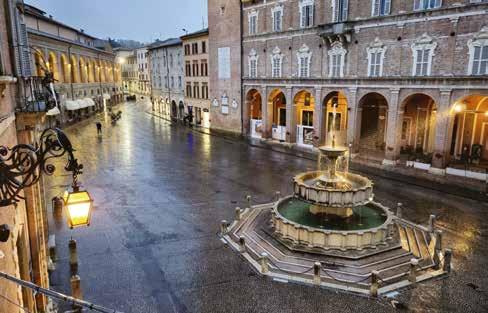
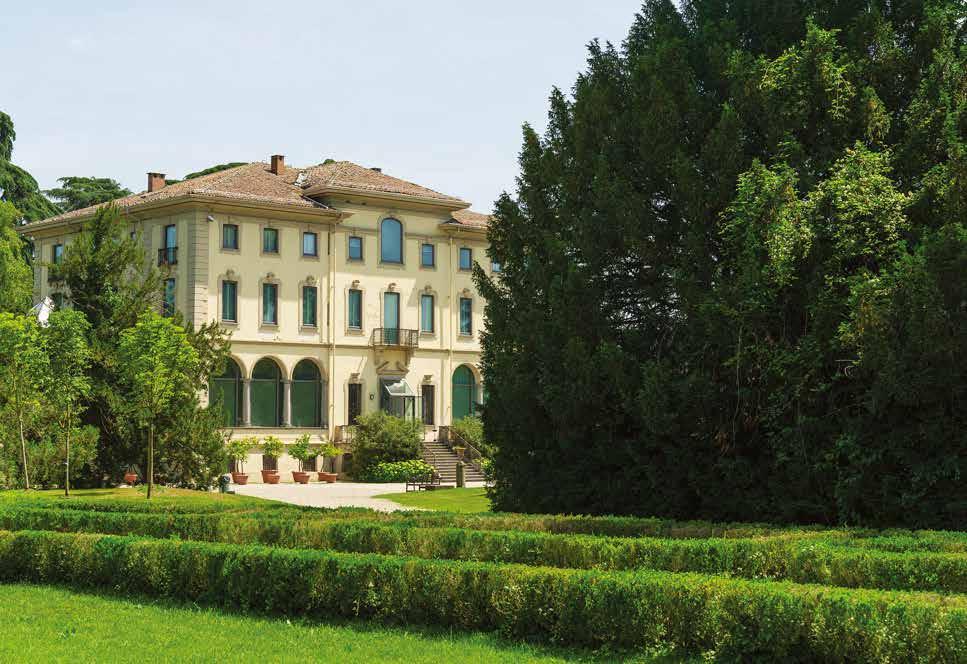
by MARCO PREPI – ph MATTIA GIANNATTASIO/KREATIVEHOUSE
Un giardino storico, recentemente restaurato grazie ai fondi europei, e una collezione d’arte che vanta una serie di capolavori assoluti. È quanto offre oggi una visita alla sede della Fondazione Magnani-Rocca di Mamiano di Traversetolo (Parma) Immersive aesthetic experience A historic garden recently restored to its original splendour thanks to European funds and an art collection boasting a series of masterpieces await visitors at Villa Magnani, the headquarters of the Magnani-Rocca Foundation in Mamiano di Traversetolo near Parma
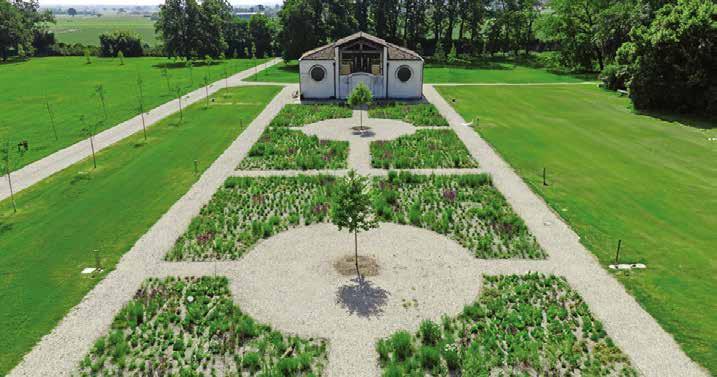
Un parco che armonizza tre diversi modelli di giardino – all’italiana, all’inglese e contemporaneo – e al suo interno una villa che custodisce le favolose opere d’arte collezionate da Luigi Magnani: capolavori di Monet, Renoir, Cézanne, Goya, Tiziano, Van Dyck e de Chirico, più una raccolta di cinquanta Morandi. Eccolo qui il motivo
Rinnovamento vero Nel corso del restauro sono state inserite oltre 8.000 nuove piante e oltre 100 nuove specie botaniche Renewal
The project saw 8,000 new plantings with over 100 new species
The home park harmonizes three different styles of garden — Italian, English, and contemporary — and surrounds a villa housing the fabulous works of art collected by Luigi Magnani which include masterpieces by Monet, Renoir, Cézanne, Goya, Titian, Van Dyck, and de Chirico, together with a collection of fifty works by Morandi, making a few hours spent at the Magnani-Rocca Foundation in Mamiano di Traversetolo an unparalleled aesthetic experience. Set in the lush Parma countryside, the park
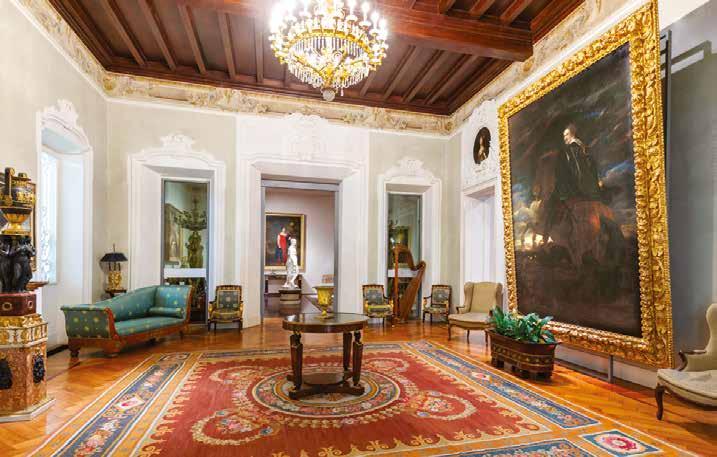

Bellezze senza tempo Conservando Goya accanto a Burri, anche la collezione d’arte all’interno della villa dimostra che il rispetto della storia può convivere con la contemporaneità
Timeless beauty Hanging Goya next to Burri, the art collection inside the villa demonstrates how respect for history can coexist with contemporaneity


per cui passare qualche ora a Mamiano di Traversetolo, all’interno della sede della Fondazione Magnani-Rocca, regala un’esperienza estetica senza eguali. Immerso nella campagna di Parma, il parco di Villa Magnani – inizialmente creato nel 1819 dal Generale Filippo Paulucci delle Roncole, successivamente trasformato da suo figlio Alessandro e dalla moglie Marianna Panciatichi, e infine completato con un raffinato giardino all’italiana di ispirazione rinascimentale da Luigi Magnani, negli anni ’60 del Novecento – è tornato al suo antico splendore grazie al restauro-record finanziato con i fondi del Piano nazionale di ripresa e resilienza (Pnrr).
Qualche numero: 12 ettari di estensione complessiva, oltre 8.000 nuove piante e oltre 100 nuove specie introdotte, oltre 900 alberi appartenenti a 37 specie botaniche censite e curate e 3 alberi monumentali iscritti nell’Elenco
La Fondazione Magnani-Rocca di Mamiano di Traversetolo oggi offre un’esperienza che va ben oltre la tradizionale visita museale
The Magnani-Rocca Foundation in Mamiano di Traversetolo now offers an experience that goes far beyond a traditional museum visit
around Villa Magnani was originally created in 1819 by General Filippo Paulucci delle Roncole and was later transformed by his son Alessandro and his wife Marianna Panciatichi before being finally completed with a refined Renaissanceinspired Italian garden by Luigi Magnani in the 1960s. It has now regained its former splendour thanks to a record restoration project financed with funds from the National Recovery and Resilience Plan.
The scale of the project is impressive; 8,000 new plants and over 100 new species were introduced into the park’s 12 hectares, joining over 900 trees belonging to 37 protected species and 3 trees listed in the Register of Italy’s Monumental Trees: a magnificent 37-metre-tall Lebanese cedar, a rare sequoia, and a spectacular plane tree. Over the years these historic trees have cast their shade over some
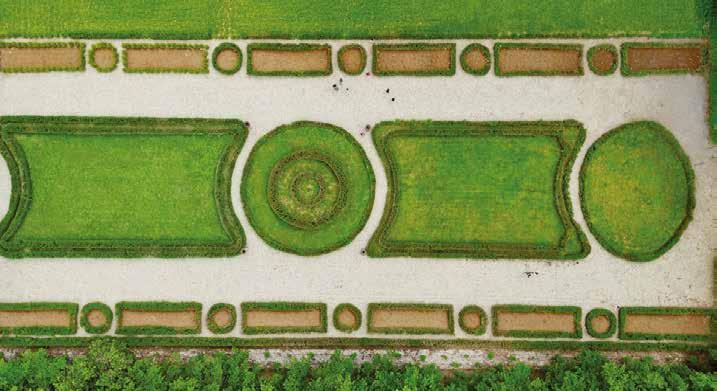
Occhio agli orari
Il Parco di Villa Magnani è visitabile da metà marzo a metà dicembre, dalle 10 alle 18 (lunedì esclusi)
Opening hours
The Park of Villa Magnani is open from mid-March to midDecember, from 10 am to 6 pm (closed on Mondays)
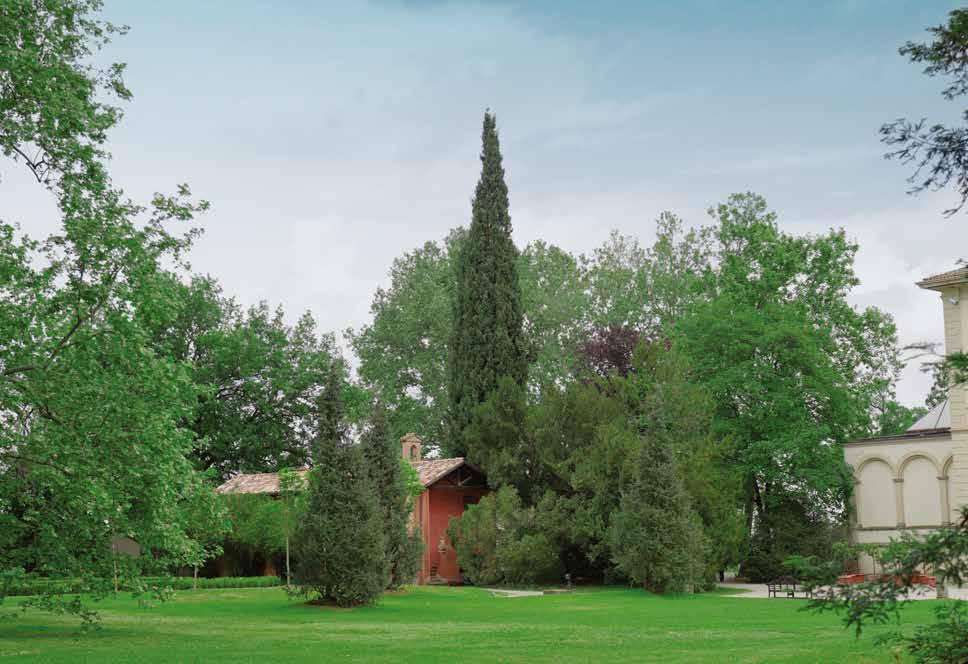
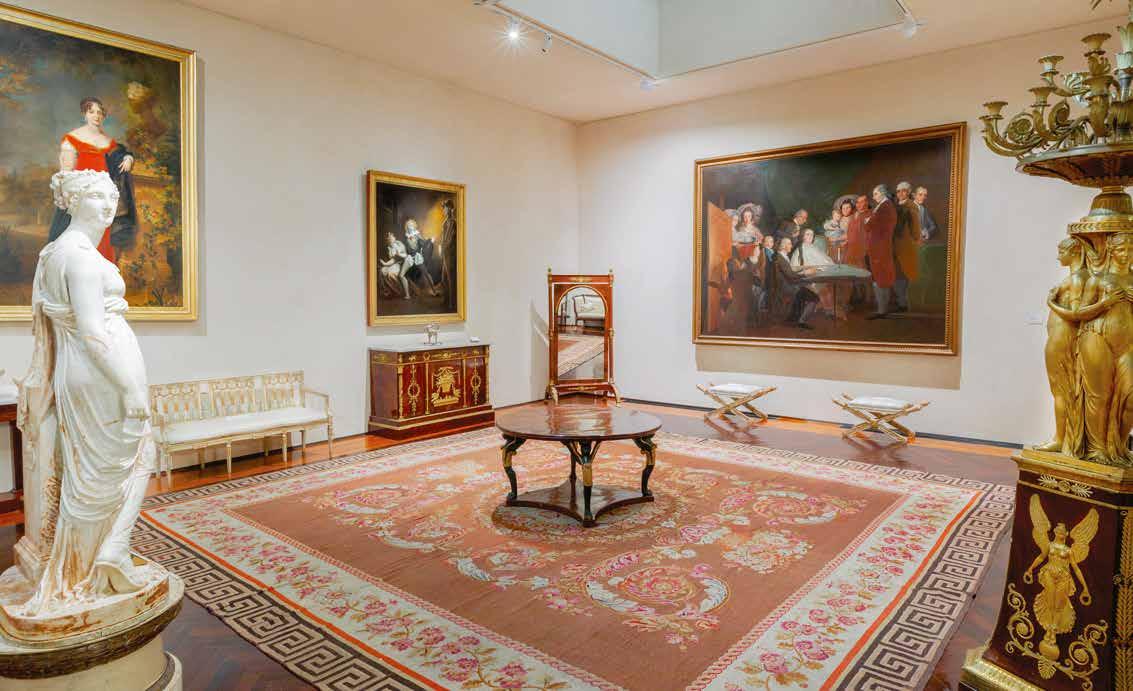
degli alberi monumentali d’Italia: un meraviglioso cedro del Libano, alto 37 metri, una rara sequoia e uno spettacolare platano.
Senza dimenticare che sotto questi stessi “giganti verdi” hanno passeggiato i più grandi esponenti della cultura italiana e del jet-set internazionale, da Eugenio Montale a Giuseppe Ungaretti, Alberto Moravia, Italo Calvino, fino alla Principessa Margaret d’Inghilterra. Ma forse l’elemento più audace del restauro è il “Giardino Contemporaneo”, un nuovo modo di pensare lo spazio verde: più libero, più vicino alla Natura e più attento al tempo. Le protagoniste sono le piante perenni, che tornano ogni anno, e le graminacee, con la loro leggerezza. Ottocento metri quadrati con oltre 6.500 piante disposte “a matrice” per fioriture da marzo a novembre, creando una moderna “collezione botanica” che traduce in chiave vegetale la visione di Luigi Magnani. Infatti, come la collezione d’arte all’interno della villa conserva Goya accanto a Burri, questo angolo del parco è la concreta dimostrazione che il rispetto della storia può convivere con la contemporaneità.
Con questo restauro, la Fondazione Magnani-Rocca offre dunque un’esperienza che va oltre la tradizionale visita museale: il parco restaurato rappresenta un modello di come il patrimonio storico possa rinnovarsi senza tradire la propria identità, attirando appassionati di giardini storici, famiglie, studiosi e viaggiatori culturali da tutta Europa.
Collezione museale
La villa custodisce le favolose opere d’arte collezionate da Luigi Magnani
The collection
The villa houses the fabulous works of art collected by Luigi Magnani
of Italy’s leading literati and members of the international jet set, from Eugenio Montale to Giuseppe Ungaretti, Alberto Moravia, Italo Calvino, and Princess Margaret, sister to the late Queen Elizabeth II. But perhaps the boldest element of the restoration project is its “Contemporary Garden” reflecting a new, more relaxed and respectful way of interpreting our relationship with nature and the seasons. The protagonists are perennial plants, flowering year after year, interspersed and lightened by a range of grasses. The eight hundred square metre garden of over 6,500 plants is arranged in a matrix pattern to bloom
from March to November, creating a modern botanical interpretation translating Luigi Magnani’s vision into plant form.
Just as the villa’s art collection hangs Goya next to Burri, this corner of the park is the concrete demonstration that respect for history can coexist with contemporaneity. This restoration has transformed the MagnaniRocca Foundation into an experience that goes beyond a traditional museum.
The renovated park represents a model of how historic heritage can be renewed without betraying its identity, attracting lovers of historic gardens, families, scholars, and cultural travellers from all over Europe.
Parola di Flora Tabanelli, la giovanissima campionessa di free-style che vestirà i colori della Nazionale a Milano-Cortina 2026 “Flying through the snow is freedom and joy” claims Flora Tabanelli, the young free-style champion competing on the Italian team at the Milano-Cortina 2026 Winter Olympics
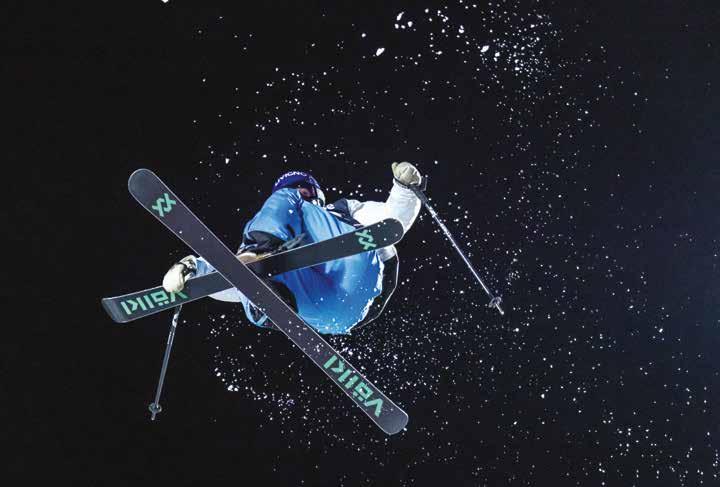
Guardare tutti dall’alto a 17 anni è sfida improba per (quasi) tutti, ma non per Flora Tabanelli, stella dello sci freestyle e detentrice di una lunga serie di record. Il triplice successo nel big air in Coppa del Mondo, X-Games e Mondiali ha suggellato un 2025 indimenticabile e confermato la bontà di un talento precoce, peraltro condiviso con il fratello maggiore Miro (21 anni e primo italiano a salire sul podio di una gara di Coppa del Mondo di big air).
Lo stile eclettico e la creatività nel tentare trick di grande impatto hanno permesso al volto d’angelo della spedizione
by ALESSIO CAPRODOSSI foto/photo PENTAPHOTO
Being at the top of your game at the age of just 17 might be considered daunting by most people – but not by Flora Tabanelli, freestyle skiing star and holder of an impressive list of records. Her triple successes in the big air event at the World Cup, X-Games and World
Championships crowned an unforgettable 2025 and confirmed the brilliance of this early-blooming talent, one she shares with her older brother Miro, who at 21 years old became the first Italian ever to win a World Cup medal for the big air event. Her eclectic style and creativity in attempting
azzurra di arrivare all’impegno della vita nelle condizioni psico-fisiche ideali. Una escalation senza freni cui manca il brindisi più atteso: una medaglia olimpica sulle piste di casa. Che è lo scenario perfetto per mostrare al mondo un inedito salto d’autore.
Ciao Flora, come stai e come va il percorso di avvicinamento ai prossimi impegni?
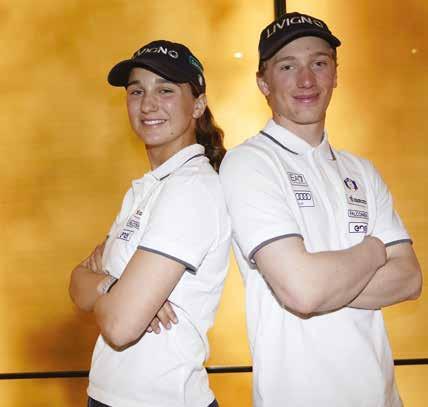
“Sto alla grande, dopo una estate di allenamenti proficui, in cui ho provato nuovi trick, aumentato la forza e svolto diverse attività, con e senza gli sci”.
L’obiettivo è Olimpiadi Milano-Cortina: cosa ti aspetti?
“I Giochi in Italia sono un sogno e c’è tanta emozione. Anche perché Livigno è una seconda casa per me. La grande attesa mi dà qualche pensiero, ma mi sento pronta a regalare gioie”.
Com’è vivere la carriera sportiva insieme a tuo fratello Miro?
“È una fortuna immensa, perché viaggiare con lui è comodo, mentre poter condividere le esperienze è un enorme privilegio. Muoversi in due, inoltre, tranquillizza i miei genitori (ride, ndA)”.
Quanto ha influito sul tuo percorso essere cresciuta al rifugio del Lago Scaffaiolo (gestito dai genitori), sul crinale tosco-emiliano?
“Al Rifugio Duca degli Abruzzi è iniziato tutto, avevo 3 anni e già andavo con gli sci, per prendere confidenza con la neve. Poi c’è stato il pattinaggio su ghiaccio e quattro anni di snowboard. Ero brava in entrambe le discipline ma in breve tempo ho trovato la mia via nel freestyle, che mi ha dato pulsioni uniche, come l’impagabile sensazione di libertà che generano salti e discese”.
Come si conquistano i giudici in gara: acrobazie, coraggio, pulizia nei movimenti, atterraggio, improvvisazione. Cosa fa la differenza?
“Da fuori può sembrare che facciamo salti casuali, perché tanti dettagli non si carpiscono. Il numero di rotazioni, l’atterraggio, il controllo del corpo, l’ampiezza del salto sono alcuni dei fattori che determinano il parere dei giudici”.
high-impact tricks have enabled this angel-faced leader of the Italian team to face the most important challenge of her life in perfect physical and mental shape. Her career has been an ascending curve waiting to be crowned by that most glittering of prizes: an Olympic medal on home snow. The perfect stage to unveil to the world a brandnew signature jump.
Hi Flora, how are you doing and how is the run-up to your next competitions going?
“I’m great thanks, after a brilliant summer of training where I tried new tricks, built up my strength and did a range of activities, both on and off skis.”
The goal is the MilanoCortina Olympics: what are you expecting?
“The Olympic Games in Italy are a dream and it’s hugely exciting. Especially since Livigno is like a second home to me. The weight of expectation is giving me a few jitters, but I feel ready to bring joy.”
In amicizia
What’s it like pursuing a sporting career alongside your brother Miro?
“It’s an enormous privilege, because travelling with him is easy, and being able to share experiences is a huge advantage. Travelling together also reassures our parents (laughs).”
How much did growing up at the Lago Scaffaiolo mountain refuge - run by your parents - in the Tuscan-Emilian mountains influence your career?
“It all began at the Duca degli Abruzzi mountain refuge. I was three years old and already on skis, getting used to the snow. Then came ice skating and four years of snowboarding. I was good at both, but I soon found my true calling in freestyle, which gave me unique thrills – above all, the priceless sense of freedom that comes with jumps and descents.”
“Sono una delle atlete più giovani di uno sport giovane in cui ci si sostiene l’uno con l’altro” Friendship “I’m one of the youngest athletes in a young sport where we all look out for each other”

“I
“Ricevo
sempre tanti complimenti, ma leggere il messaggio di Alberto Tomba è stata una sensazione incredibile”
get a lot of compliments, but getting a message from Alberto Tomba was incredibly special”
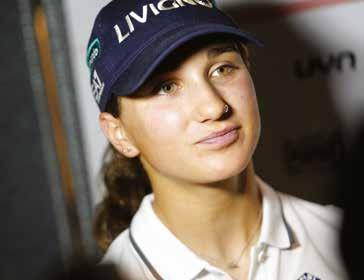
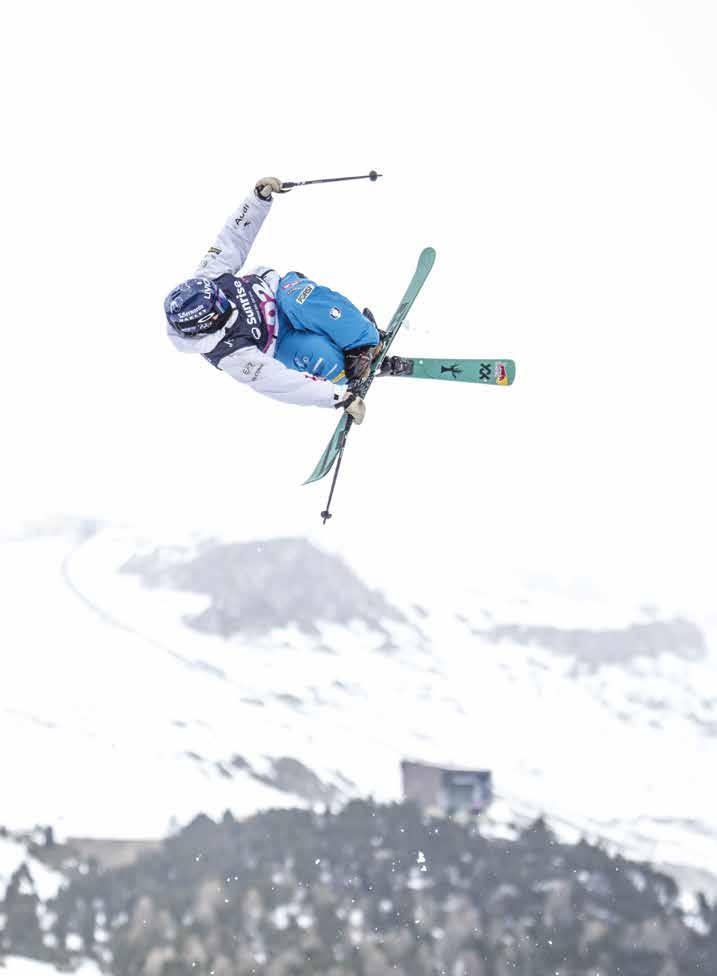
Saltare e raggiungere altezze che sfiorano i 20 metri implica insidie per ginocchia, schiena e il resto del corpo: ci sono tecniche mentali per battere la paura?
“La concentrazione è la chiave. Sapere cosa fare prima di iniziare, con la consapevolezza che stai per fare qualcosa che hai provato tante volte e che sai eseguire molto bene. È cruciale mantenere la calma, specie quando non sei al 100%, poi l’esperienza aiuta a gestire la gara. Ricordando che nel freestyle tutti cadono, ma se impari a cadere puoi limitare i danni”.
Ti senti un’adolescente felice nel fare ciò che più ti piace o senti che manca qualcosa rispetto ai tuoi coetanei?
“Sono sempre fuori casa ma faccio quello che adoro e vivo esperienze grandiose. La possibilità di vedere il mondo e conoscere persone ovunque è un altro dei motivi per cui non cambierei mai la mia vita”.
Il posto nel mondo che ti esalta?
“Purtroppo non sempre riesco a visitare i Paesi in cui andiamo per gare e allenamenti. È successo, però, in Cina e la Grande Muraglia ti lascia senza fiato. Un luogo che adoro è la Nuova Zelanda, dove andiamo con la Nazionale tra agosto e settembre per la prima sciata dell’anno”.
Qual è il tuo sogno?
“Diventare un riferimento nel mio sport, non solo con le vittorie, ma anche ispirando le ragazze più giovani a trovare la loro strada”.
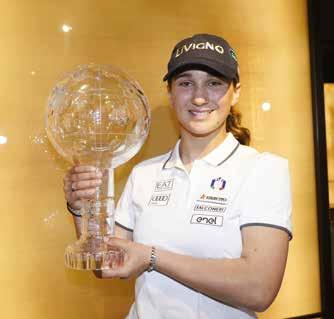
Multisport
“Gli allenamenti variano da salti su neve artificiale, palestra e tanto stretching. Ma c’è sempre spazio per altri sport, utili per imparare e sentirmi meglio”
Multisport
“Training ranges from jumps on artificial snow, to the gym and plenty of stretching. But there’s always room for other sports too, which are useful for learning and for fun.”

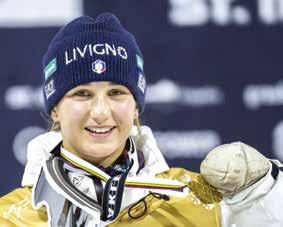
Apripista
“Mia sorella più grande, Irene, è stata la prima a trasferirsi dall’Emilia in Trentino. Faceva sci alpino e ha aperto la strada, dimostrando che sin da piccoli potevamo camminare da soli anche lontano da casa”
Trail blazer
“My big sister Irene was the first of us to move from Emilia to Trentino. She did alpine skiing and blazed the trail, showing you can thrive away from home even if you are young”
How do you convince the judges you have an edge in competitions – acrobatics, courage, clean execution, landing, improvisation? What makes the difference?
“To a non-expert eye, it might look as if we’re just doing random jumps, because many of the details are hard to catch, but some of the factors that influence the judges’ verdict are the number of turns, the landing, body control and the size of the jump.”
Jumps of almost 20 metres involve risks for your knees, back and the rest of the body. Are there any mental techniques to overcome fear?
“Concentration is the key. Knowing what you have to do before you start, with the awareness that you’re about to do something you’ve practised many
Programmazione
“Nei due giorni prima della gara pianifico tutto con l’allenatore: lui mi consiglia, poi decidiamo insieme i trick da eseguire” Planning
“Two days before the event I plan everything with my trainer: he gives me advice and then we decide which tricks to do together”
times and know how to perform well. Staying calm is crucial, especially when you’re not feeling 100 per cent, which is when experience helps you handle competition pressure. And you always have to remember that in freestyle everyone falls –but if you learn how to fall, you can limit the damage.”
Do you feel like a happy teenager doing what you love most, or do you think you’re missing out on something compared to your peers?
“I’m always away from home, but I do what I love and live incredible experiences. Having the chance to see the world and meet people everywhere is another reason why I would never change my life.”
The place in the world that excites you most?
“Unfortunately, I don’t always see very much of the countries we go to for training and competitions. But I did manage in China, and the Great Wall is truly breathtaking. Another place I adore is New Zealand, where we go with the Italian national team in August and September for the first skiing of the year.”
What’s your dream?
“To be a beacon for my sport, not only through victories, but also by inspiring youngsters to take it up.”

Imperdibile
Lo strudel di mele, un intramontabile classico
A must
Apple strudel, a classic
Un viaggio fra tradizione, eleganza e irresistibili tentazioni nella splendida Merano Autumn, sweet autumn All the traditions, elegance and irresistible temptations of marvellous Merano
by VIRGINIO PRETZI
Merano, nella sua bellezza autunnale Mitteleurope
Merano in all its autumn glory
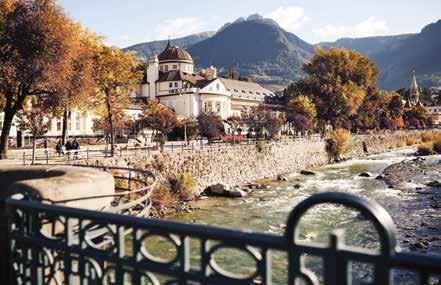
Quando la natura sfuma nei colori dorati dell’autunno, Merano si fa dolce non solo nel foliage, ma anche a tavola. Nel cuore dell’Alto Adige, dove si incontrano cultura italiana e mitteleuropea, è fiorita una tradizione dolciaria unica, che mescola il gusto alpino con le influenze viennesi e asburgiche. E Merano, con il suo fascino liberty e il suo charme portato con leggerezza, è lo scenario perfetto per assaporare il meglio di questa eredità.
Caffè e pasticcerie dipingono il paesaggio urbano. Locali storici e altri più moderni, in linea con i tempi – sempre più diffusa le prelibatezze “mignon” – ma che rispettano il passato, eleganti e al contempo capaci di conservare l’informalità che prelude alla dolcezza.
Tra i protagonisti di queste atmosfere non può mancare il grande classico: lo strudel di mele, magari servito tiepido con una spolverata di zucchero a velo e accompagnato da panna montata o salsa alla vaniglia. Un dolce che racconta l’anima contadina e casalinga dell’Alto Adige, basato su uno degli ingredienti più diffusi ed emblematici di questa terra, il frutto di Eva. Semplice, se vogliamo, ma capace di conquistare ogni palato.
Accanto allo strudel, spazio anche ai capolavori della tradizione austroungarica, come la celebre Sacher, la torta viennese per eccellenza, con la sua copertura di cioccolato fondente e il delicato strato di confettura all’albicocca. Ma c’è anche una dolcezza più discreta, ma profondamente identitaria, che merita un posto d’onore tra le specialità locali: il cuore di castagna, in tedesco Kastanienherz.
Törggelen
Anche le semplici castagne arrosto diventano protagoniste delle tradizioni autunnali
dell’Alto Adige
Even simple roast chestnuts play a leading role in the autumnal traditions of the South Tyrol
Autumn is the sweet season in Merano as nature ushers in the golden hues of the superb foliage and its bounty provides the ingredients for the town’s famed pâtisserie.
In the heart of South Tyrol, where Italian flair meets Central European tradition, a unique confectionery culture has flourished blending Alpine flavours seamlessly with Viennese and Habsburg influences. And Merano, with its Art Nouveau elegance and effortless charm, provides the perfect backdrop to a gourmet tour savouring this unique heritage. Cafés and patisseries enliven the townscapesome historic, others more contemporary, keeping pace with the times and catering to the growing fashion for dainty “mignon” delights.
Yet all retain a certain respect for the past: elegant, welcoming, and delightfully informal, they embody the very spirit of indulgence.
No celebration of Merano’s sweet traditions would be complete without that great classic apple strudel.
Best served warm with a dusting of icing sugar, perhaps accompanied by whipped cream or a pool of vanilla sauce, it is redolent of South Tyrol’s rural soul and domestic warmth. Based on the region’s famed apples -the fruit that tempted Eve - this is a simple dessert, yet one capable of charming even the most refined of palates. Sharing the spotlight are the other masterpieces of Austro-Hungarian pâtisserie: the iconic Sachertorte, Vienna’s
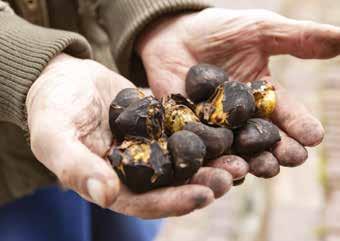

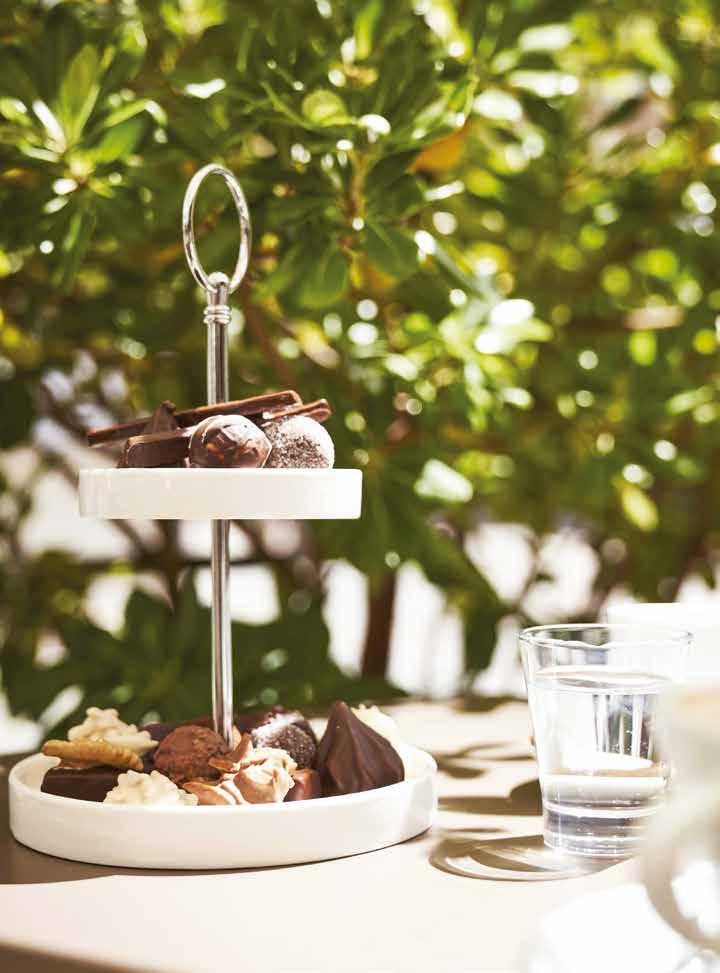
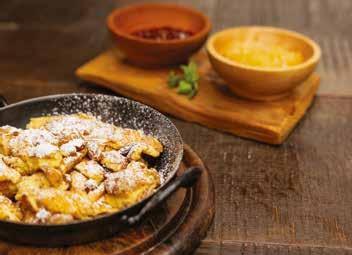
Piccole bontà: l’ideale abbinamento ad un caffè lungo il Passirio Dainty treats: the ideal accompaniment to a coffee on the Passirio
Si tratta di un dessert a base di purea di castagne e cioccolato, creato nel Dopoguerra per una festa di fidanzamento a Bolzano. Ha conquistato rapidamente il cuore (è proprio il caso di dirlo) degli altoatesini. La preparazione prevede castagne bollite, zuccherate e schiacciate fino a ottenere una purea modellata a forma di cuore, poi ricoperta da uno strato di cioccolato fuso, il tutto completato con panna montata.
Oltre a Sissi, c’è altro di regale nei menù meranesi: il Kaiserschmarrn. Il suo nome racconta già una storia: deriva dal tedesco Kaiser, “imperatore”, e Schmarrn, termine colloquiale che significa “pasticcio”. Letteralmente, è la “frittata dell’imperatore” – e non a caso, pare fosse uno dei dessert preferiti dell’imperatore Francesco Giuseppe. È una sorta di crêpe spessa e soffice, preparata con una pastella a base di uova, farina, latte e zucchero. Una volta cotta, viene spezzettata grossolanamente in padella e leggermente caramellata con il burro, fino a raggiungere una consistenza dorata e irresistibile. Servito caldo, viene spolverato con zucchero a velo e accompagnato da confettura di ribes, mirtilli rossi o salsa di mele, a seconda della zona e della stagione. Il contrasto tra la dolcezza dell’impasto e l’acidità della frutta crea un equilibrio perfetto.
A chiudere il percorso non possono mancare i Marillenknödel, i celebri canederli dolci all’albicocca. Diffusi nella cucina austriaca (soprattutto a Vienna), in quella boema, morava e triestina, trovano una loro versione autentica anche nelle valli altoatesine, dove sono considerati un prodotto agroalimentare tradizionale. Il nome deriva dal termine austriaco Marillen, che significa “albicocche”, frutto coltivato in zone vocate come la Wachau (vallata austriaca) e la Val Venosta. I Marillenknödel, insieme ai loro cugini ai frutti di susina, offrono una dolce esperienza che unisce il gusto pieno della frutta alla consistenza morbida dell’impasto. Un altro esempio, tra i tanti, di come a Merano il dolce sappia essere cultura, memoria e gioia insieme.

New flavours
Confectioners in the South Tyrol have worked hard to keep their traditions alive, but have also focused on innovating to cater to the tastes of new generations
Tradizioni
Sua maestà la Sacher Traditions
His Majesty the Sachertorte

most famous cake, cloaked in dark chocolate with a fine layer of apricot preserve at its heart. Equally beloved is a perhaps lesser-known local speciality: the Kastanienherz, or chestnut heart. This post-war creation, first made in Bolzano for an engagement party, swiftly earned a place of honour in the hearts of the inhabitants of South Tyrol. The chestnuts are boiled, sweetened and mashed into a purée, shaped into a heart and covered in melted chocolate before being topped with whipped cream.
Royal associations are never far from Merano’s dessert menu. Take the Kaiserschmarrn, where Kaiser translates as emperor and Schmarrn is a colloquial word for “mess”. Often called “the Emperor’s Pancake,” it was reputedly one of Emperor Franz Joseph’s favourites. This thick, fluffy crêpe made with eggs, flour, milk and sugar is torn into rough pieces in the pan,
caramelised in butter until golden, then dusted with icing sugar and served hot with redcurrant jam, lingonberries, or apple compote according to the place and the season. Its appeal lies in the contrast between the soft, sweet batter and the fruit’s refreshing tartness. Rounding off this journey through Merano’s puddings and sweets are its Marillenknödel - sweet apricot dumplings (known as canederli locally). A staple of Austrian (especially Viennese), Bohemian, Moravian and Triestine cuisine, they have also become a cherished tradition in South Tyrol, where they are now considered a heritage food. The name comes from the Austrian word Marillen, meaning apricots, the speciality fruit of the Wachau Valley in Austria and the Vinschgau Valley or Val Venosta locally. These canederli, which may also be made with plums, offer a delightful combination thanks to the lushness of ripe fruit wrapped in a tender dough. Another shining example of how, in Merano, sweetness is more than just flavour - it is culture, memory, and joy entwined.
by MARCO PREPI

No, non stiamo scherzando. Ma oltre a questo distillato c’è anche spazio per gin, birre artigianali, formaggi e caffè. Il tutto grazie all’operosità di Stefan e Manfred Volgger, due fratelli che oltre all’ospitalità del Gassenhof, l’albergo di famiglia, hanno dato vita al Genusshaus Mount Becher, piacevolissimo luogo di perdizione etilica… Whisky galore in Val Ridanna No, we’re not joking. And apart from whisky you can also get gin, craft beer, cheese and coffee. All thanks to brothers Stefan and Manfred Volgger, who combine running their family hotel the Gassenhof with their passion project the Genusshaus Mount Becher, a perfect place to practice the pleasures of alcoholic perdition…

La Val Ridanna resta un luogo magico. Un po’ perché è cieca e quindi naturalmente più riservata e tranquilla, un po’ perché è sempre stata al margine dello sviluppo turistico (a volte eccessivo) dell’Alto Adige e ha saputo conservare ancora oggi una propria sincera identità. Per la famiglia Volgger sono valori da condividere con gli ospiti del Gassenhof, il loro hotel nato come piccola pensione a metà degli anni ’70 e cresciuto sino a diventare un piacevolissimo 4 stelle superior, dove staccare la spina, dimenticarsi delle code in montagna e godersi la vita. Stefan e Manfred Volgger, i due fratelli che portano avanti l’attività, hanno le idee chiarissime e sanno quanto importante sia far star bene gli ospiti, 12 mesi all’anno. Ma nella mezza stagione la Ridanna raggiunge la sua massima bellezza e occorre portarle un saluto, prima di godere del silenzio e della quiete assoluta che si respira da queste parti. Il tutto cullati dall’abete, dalla pietra e dal vetro di cui è fatto il Gassenhof (www.gassenhof.com) una struttura
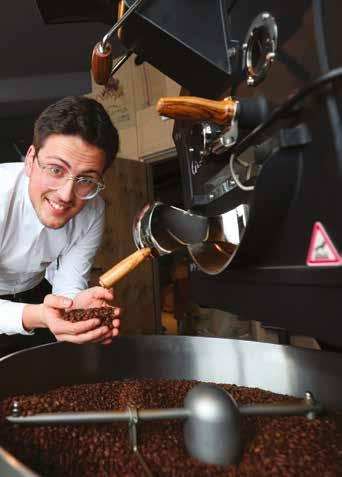
Val Ridanna is one of those magic places.
Partly because it’s a side valley with no through traffic, making it naturally quieter and more reserved, and partly because it has always been a bit off the beaten track of South Tyrol tourism (which can be OTT) and has managed to maintain its authenticity intact.
Il Re dei distillati nel suo regno
The distiller in chief in his element
All values the Volgger family are eager to share with guests at the Gassenhof, the family hotel that started life as a modest pensione in the mid-1970s and gradually grew into a pleasingly plush superior 4-star hotel. This is the ideal destination to relax and get away from it all, forgetting about queues on the mountain trails elsewhere and just enjoying a laid-back life.
Stefan and Manfred Volgger, the two brothers who run the business, have their priorities clear and know how important it is to make guests feel welcome all year round. But it’s during the mid-season that
Ridanna reaches its peak beauty, and the shoulder season is an ideal time to enjoy the silence and total peace, wrapped in the natural warmth of the pine wood, stone, and glass of the Gassenhof (www.gassenhof.com).
The hotel blends nicely into the landscape, while still boasting 3,000 square metres of wellness facilities to ensure guests are pampered to the hilt. There is the Gassenbadl in the main building, with its pool and famous grappa sauna, where daily steam rituals are held alongside tastings of spirits produced by the Volgger family. Equally fascinating is the Logen-Spa, with its outdoor infinity pool, panoramic saunas, yoga areas, and beauty treatments.
Whisky d’altura Dai primi esperimenti ad oggi sono passati diversi anni, ma il risultato ha superato le migliori aspettative Whisky high Years have passed since the initial experiments, but the results were well worth the wait
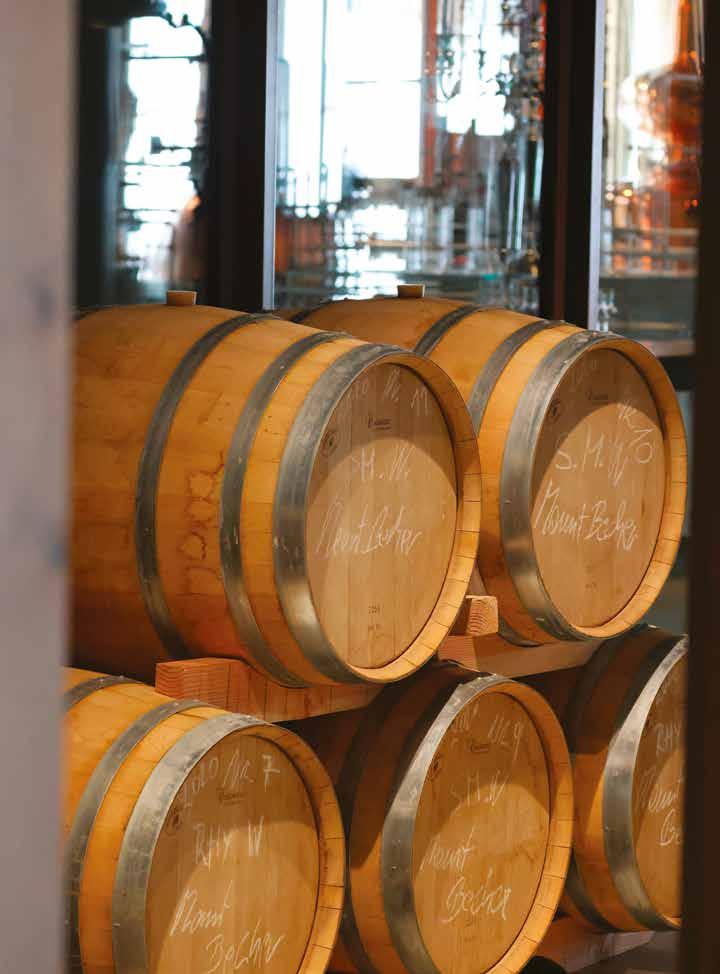
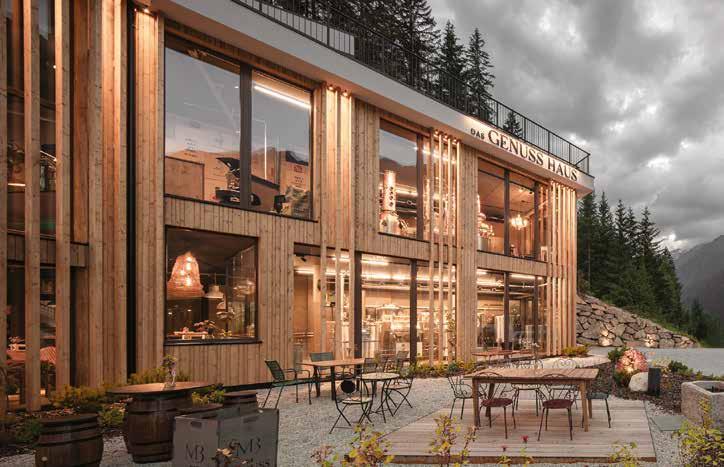
ben integrata con il territorio circostante che nasconde 3000 metri quadrati di centro benessere. C’è la Gassenbadl, nell’edificio principale che oltre alla piscina, offre la celebre sauna alla grappa, dove ogni giorno vengono celebrati rituali di vapore con degustazioni di distillati prodotti dalla famiglia Volgger. Non meno interessante la Logen-Spa con piscina infinity all’aperto, saune panoramiche, aree yoga e trattamenti di bellezza. A questo punto a voi la scelta: relax totale nelle due Spa o un mix di attività in valle che spaziano dalle passeggiate alle ciaspolate in funzione della stagione? Ma c’è anche una terza possibilità, perfetta per chi ama formaggio, birra e distillati, il Genusshaus Mount Becher. Qui, tutto è prodotto in casa: dalla birra artigianale alla grappa, dal gin raffinato alla tostatura del caffè acquistato da realtà equo-solidali del Sud America. Tutta colpa di Manfred Volgger che nel 20212 avvia un’autoproduzione artigianale di grappa, trasformando una passione personale in una vera e propria eccellenza: da allora, infatti, il suo amore per i distillati non ha mai smesso di evolversi, allargandosi nel corso degli anni anche al mondo del gin e della birra artigianale, che viene realizzata a partire dal malto coltivato in Alto Adige e dall’acqua pura della Val Ridanna.
Poi è stata l’ora del whisky, che ha ampliato l’offerta stupendo gli amanti di questo prodotto per i profumi che
Spazio gourmet
La Genusshaus Mount Becher
Gourmet destination
The Genusshaus Mount Becher
At this point, the choice is yours: total relaxation in the two spas or add on some of the activities available in the valleywhich range from hikes to snowshoeing, depending on the season. But there’s also a third option for those who appreciate great cheese, beer, and spirits:
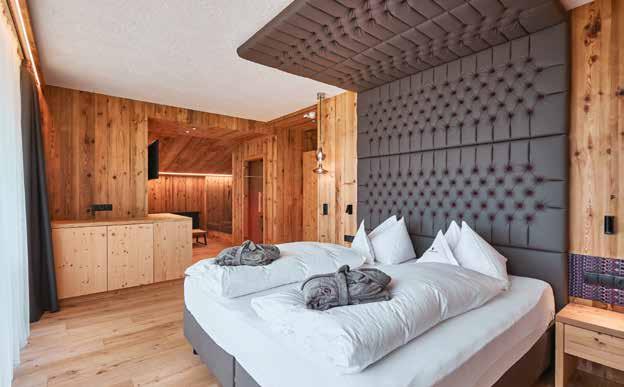
Linee moderne
Una delle camere del Gassenhof
Contemporary design
A room in the Gassenhof
the Genusshaus Mount Becher. Everything here is homemade: from their craft beer to their grappa, their superlative gin and the coffee roasted with beans sourced from fair-trade producers in South America. All thanks to Manfred Volgger, who in 2012 started producing his own artisanal grappa, turning a personal passion into true excellence. Since then, his love affair with distillates has never stopped evolving, expanding over the years to include gin and craft beer made from malt grown in South Tyrol and the pure water of the Ridanna Valley. Then came whisky, broadening the choice and delighting refined palates able to detect the bouquets Manfred has managed to infuse into his product. More recently, the Volgger brothers also began making cheeses, offering a range of both aged and fresh varieties, all exclusively made with milk from cows fed on local hay. Because the Genusshaus Mount Becher is not just a tasting experience. It is a tribute to the history and generous nature of the Ridanna Valley. Each product carries with it a piece of this land: the Schwarzwand and Rochol coffees are named after local peaks, as are the
Manfred ha saputo donargli. Di recente, i fratelli Volgger hanno avviato anche una produzione di formaggi, con diverse varietà tra stagionati e freschi, ottenuti esclusivamente da latte di fieno altoatesino.
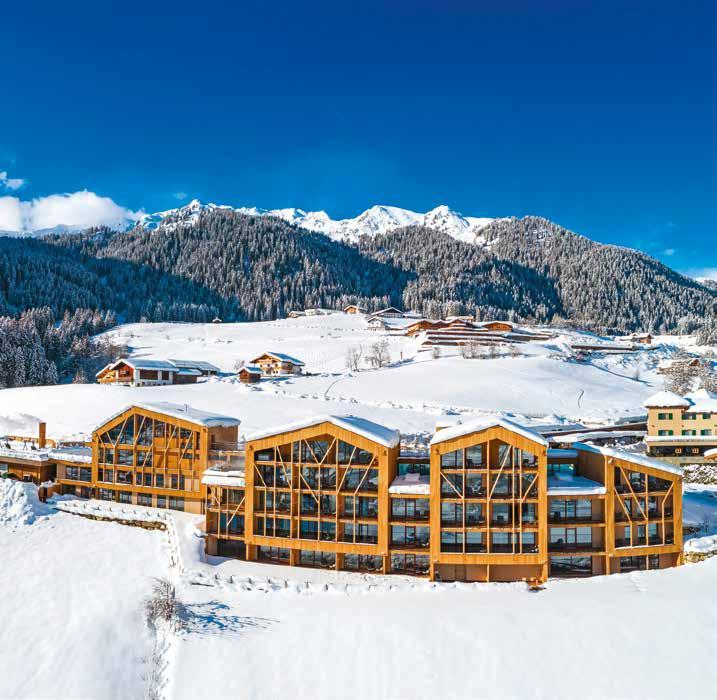
La Genusshaus Mount Becher non è solo un’esperienza di gusto. È anche un omaggio alla storia e alla natura della Val Ridanna. Ogni prodotto porta con sé un pezzo di questa terra: i caffè Schwarzwand e Rochol prendono il nome dalle cime locali, così come le birre artigianali Becherfels e Erzader. La vodka “1253” celebra l’anno della prima documentazione storica esistente della Val Ridanna, mentre il gin “ArGINtum” si rifà al termine latino “Argentum”, un tributo alle storiche miniere d’argento della zona. Lo stesso nome dato alla Genusshaus, “Mount Becher”, è in omaggio al Rifugio Biasi al Bicchiere, il più alto dell’Alto Adige, che dal 1911 ospita la cappella di Santa Maria della Neve. Un luogo suggestivo a cui i fratelli Volgger sono molto legati, tanto da renderlo parte di un loro progetto speciale: è qui, a 3.195 metri di altitudine, che hanno portato tre delle loro botti di legno, per affinare in alta quota ben 127 bottiglie di whisky in occasione del 127° anniversario del rifugio Bicchiere.
Natura
L’albergo della famiglia Volgger, nel cuore della val Ridanna Nature
The Volgger family hotel in the heart of the Ridanna valley
Becherfels and Erzader craft beers. The “1253” vodka celebrates the year of the earliest existing historical record of the Ridanna Valley, while the gin “ArGINtum” recalls the Latin word Argentum, a nod to the area’s historic silver mines. Even the name of the Genusshaus, “Mount Becher,” is a tribute to the Biasi al Bicchiere mountain refuge chalet, the highest in South Tyrol, which since 1911 has housed the Chapel of Our Lady of the Snows. This evocative place holds a
special place in the hearts of the Volgger brothers, so much so that they made it part of one of their unique projects. They brought three of their wooden casks up here, to 3,195 meters above sea level, to age the whisky for 127 bottles at high altitude to mark the 127th anniversary of the Bicchiere mountain refuge.
Un’esclusiva selezione di vini dedicata al servizio di business class
Dai pendii del Triveneto, passando sulle dolci colline toscane, attraverso il tacco pugliese fino all’assolata terra siciliana: questo ed altri affascinanti scenari ospitano alcune delle tenute più suggestive che abbiamo selezionato per voi. Lasciatevi emozionare da questi vini, dalla loro storia, dal loro sapore e dalla tradizione della terra che rappresentano, chiedendo ai nostri assistenti di volo i vini in rotazione
PIETRAGRANDE VIGNETI DELLE DOLOMITI I.G.T. ◆ Cantina: TENUTE LUNELLI
Chardonnay 80%, Sauvignon, incrocio Manzoni e Pinot Bianco 20%; 12,5% vol.; 10-12 °C
Selected for you. An exclusive wines’ selection dedicated to business class service
From the mountain slopes in the Triveneto to the sweet tuscan hills, by way of the heel of Italy in Apulia and as far as sunny Sicily: this and other fascinating scenarios are home to some of the most evocative estates we have selected for you. Be enticed by these wines, their history, taste and traditions of the lands they represent. Ask our cabin crew about wines in rotation
Pietragrande è uno Chardonnay intrigante e di fascino che conquista per l’eleganza aromatica e delicata persistenza, impreziosite da un tocco di Sauvignon. Frutto di una sapiente vinificazione tesa a valorizzare il Trentino come terra d’elezione di una viticoltura di montagna salubre e sostenibile. Fruttato e dolce nei profumi, concede fresche percezioni di fiori bianchi alternate a note di frutta a pasta bianca ed erbe aromatiche a contorno. In bocca è vivace per freschezza e sapidità, il sorso avvolgente e morbido, piacevoli i ritorni agrumati ed elegante il finale con accenni minerali.
Pietragrande is an intringuing and charming Chardonnay that captivates with its aromatic elegance and delicate persistance, enhanced by a touch of Sauvignon. It is the result of skiful vinification aimed at promoting Trentino as the land of choice for healthy and sustainable mountain viticulture. Fruity and sweet on the nose, it offers fresh hints of white flowers alternating with notes of white fruit and aromatic herbs. On the palate, it is lively and fresh, evoloping and smooth, with pleasant citrus and an elegant finish with mineral hints.
IL BRUCIATO BOLGHERI DOC 2023 ◆ Cantina: MARCHESI ANTINORI
Cabernet Sauvignon 38%, Cabernet Franc 22%, Merlot 19%, Syrah 15%, Petit Verdot 6%; 14% vol.; 16-18 °C
Il Bruciato nasce nel 2002, in una delle più difficili vendemmie di Tenuta Guado al Tasso, per raccontare e far conoscere secondo uno stile moderno il terroir unico di Bolgheri. Le uve accuratamente selezionate, provengono da vigneti situati su suoli con un’ampia variabilità geologica capaci di esprimere una grande complessità.
AIl Bruciato was first produced in 2002 in one of the most difficult vintages ever for the Guado al Tasso estate. The wine is a modern interpretation of Bolgheri’s unique terroir made from carefully selected grapes from Tenuta Guado al Tasso’s vineyards. The geological composition of the soil is diversified giving the wine structure and complexity.
VALDOBBIADENE PROSECCO D.O.C.G. LA RIVETTA 120 0 ◆ Cantina: VILLA SANDI
Glera 100%; 11% vol.; 6-8 °C
Ha un colore giallo paglierino brillante con marcati riflessi verdognoli, con una bollicina fine e delicata; al naso ricorda sentori di mela granny smith, fiori di glicine e acacia. Al gusto risulta fresco e fragrante con un ritorno aromatico particolarmente fruttato.
It has a brilliant straw yellow color with marked greenish glints and a fine and delicate perlage. The aroma recalls hints of Granny Smith apple, wisteria and acacia flowers. The taste is fresh and fragrant with a particularly fruity aromatic return.

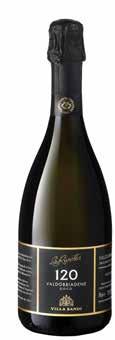

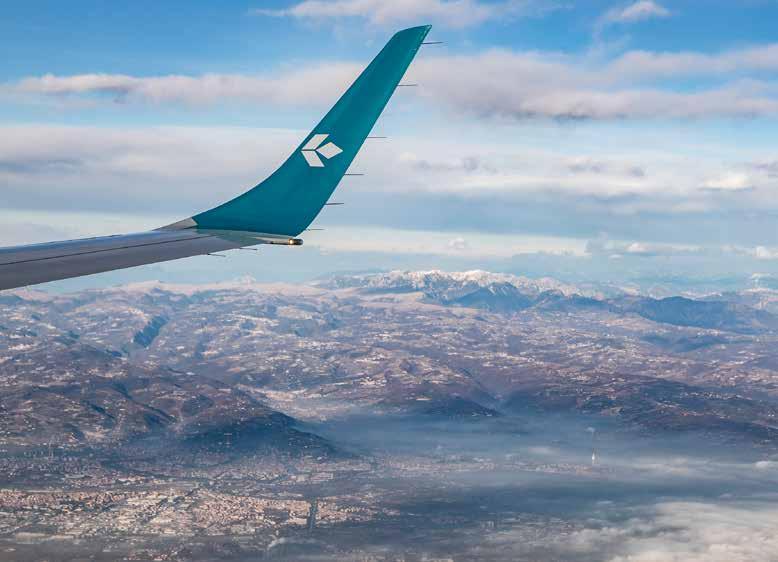

Inflight entertainment: www.boardconnect.aero
Un’ampia scelta di quotidiani e riviste digitali per il tuo viaggio, gratuitamente a disposizione. Scopri il nuovo servizio eJournals per i passeggeri Air Dolomiti.
A wide choice of newspapers and magazines is now available and free for Air Dolomiti passengers. Enjoy the new eJournals service

Grazie al nuovo e sofisticato sistema di Inflight Entertainment tutti i passeggeri possono ora accedere gratuitamente ad una serie di contenuti: giornali, magazines, video, musica e giochi. Come fare? L’accesso è rapido e semplice e non è necessario scaricare alcuna applicazione. È sufficiente impostare il proprio dispositivo (smartphone, tablet, laptop) in modalità aereo prima del decollo e attivare la connessione Wi-Fi dalle proprie impostazioni: selezionare la rete ENWIFI e accedere a www.boardonnect.aero. E-journals: per i giornali e magazines il sistema permette il download in formato pdf della testata desiderata, che sarà quindi leggibile in qualsiasi momento. I video, giochi, musica sono distribuiti in modalità streaming e quindi disponibili solo a bordo.
Digitale Zeitungen und Zeitschriften sind nun kostenlos für unsere Air Dolomiti Passagiere auf all unseren Flügen verfügbar. Entdecke die große Auswahl unseres eJournals.
http://service.airdolomiti.it/mediatrack
Passengers can now access a range of free newspapers, magazines, videos, music and games through our new and sophisticated In-flight Entertainment system. Access is fast and easy, no app is required. Simply set your device (phone, tablet, laptop) to airplane mode and activate the appropriate Wi-Fi: select ENWIFI and access to www. boardonnect.aero. E-journals: newspapers and magazines can be downloaded in pdf and read at your leisure. Videos, games and music are in streaming and only available on board.
Fare fotografie e riprese video a bordo è permesso solamente nel caso in cui non leda in alcun modo la privacy degli altri passeggeri e del personale di volo. Il cabin crew è autorizzato in qualsiasi momento a negare il permesso di effettuare fotografie o video
Taking photos or making videos is only permitted on board if it does not infringe on another person’s personal rights. The crew is authorized to forbid taking pictures or making videos on board at any time.
Il programma gratuito di incentivazione per piccole e medie imprese di Lufthansa Group The Lufthansa Group airlines’ free corporate bonus programme

Con le compagnie aeree di Lufthansa Group e le compagnie partner è possibile ottimizzare i costi di viaggio e accumulare preziosi punti Benefit per la vostra azienda.
◆ I punti possono essere liquidati oppure utilizzati per fruire di utili vantaggi come voli, upgrade, eccedenza bagaglio, prenotazione del posto, voucher FlyNet, accesso in lounge, premi WorldShop
◆ I membri del programma Miles & More continuano ad avere l’accredito delle miglia personali
I punti Benefit sono sempre una risorsa per le aziende: consentono di ridurre i costi di viaggio e motivare i propri dipendenti.
Con Austrian Airlines, Lufthansa, SWISS, Air Dolomiti, Brussels Airlines ed Eurowings, nonché con le compagnie aeree partner del programma Benefit: Air Canada, All Nippon Airways, Air China, LOT Polish Airlines e United Airlines, non solo potrete beneficiare di un network su tutto il territorio mondiale e di un’ampia scelta di connessioni, ma guadagnerete anche punti Benefit in quasi tutti i viaggi di lavoro.
Convinti? Potete registrare subito la vostra azienda su partnerplusbenefit.com!
Optimise your travel costs on flights with the Lufthansa Group airlines and the Benefit partner airlines and earn valuable Benefit points for your company.
• These points can be redeemed for attractive flight, travel and product awards.
• What’s more, Miles & More members continue to have their personal miles credited. One flight after another brings you to attractive awards. Reduce your travel costs with free flights or upgrades and motivate your employees.
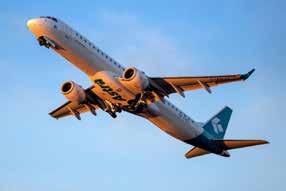
Your Benefit points are always an asset for your company. With Austrian Airlines, Lufthansa, SWISS, Air Dolomiti, Brussels Airlines and Eurowings, as well as with the Benefit partner airlines Air Canada, All Nippon Airways, Air China, LOT Polish Airlines and United Airlines, you not only benefit from a worldwide route network and a wide choice of connections – you can also earn Benefit points on almost every business trip.
Convinced? If so, register your company today at partnerplusbenefit.com!
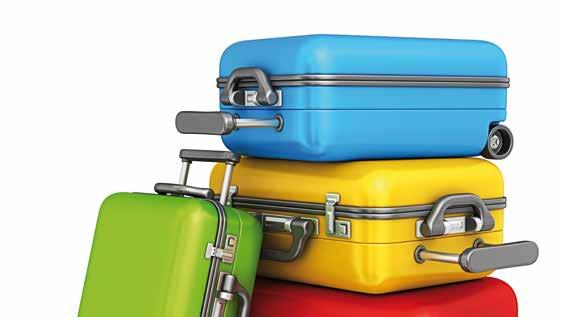
Per garantire la vostra sicurezza ed il massimo comfort a bordo dei nostri aerei, Vi invitiamo a seguire le seguenti procedure Air Dolomiti For safety reasons and for your comfort on board, we kindly ask you to follow the Air Dolomiti procedures

È consentito 1 solo bagaglio a mano (max 55 x 40 x 20 cm) del peso massimo di 8 kg per le tre tariffe economy (Light, Classic e Flex); le tariffe business (Saver e Flex) consentono invece 2 pezzi del peso massimo di 8 kg. Il bagaglio a mano può essere posizionato nella cappelliera o sotto il sedile di fronte a voi; aprite i vari spazi con cautela affinché non cada nulla.
Norme internazionali di sicurezza proibiscono di trasportare armi o altri oggetti pericolosi sia nel bagaglio spedito che in quello a mano. Sono compresi: gas compressi, corrosivi, liquidi e solidi infiammabili come ad esempio i fiammiferi.* Vi preghiamo di tener inoltre presente che, secondo le disposizioni locali, alcuni oggetti che possono provocare lesioni non vengono accettati a bordo; tra questi rientrano anche forbici, coltelli tascabili e lime per unghie. Informazioni dettagliate sugli oggetti pericolosi sono esposte in aeroporto (zona check-in).
*Tranne armi e munizioni da caccia o sportive. Per ulteriori informazioni si prega di verificare direttamente con la compagnia.
Tutti i dispositivi elettronici mobili devono rimanere spenti o in modalità “uso aereo” dalla chiusura delle porte dopo l’imbarco fino al momento dell’atterraggio. Dopo l’atterraggio e fino all’arrivo all’area di parcheggio non è consentito effettuare/ricevere chiamate telefoniche. Dispositivi quali cellulari, eBook, videogiochi e tablet possono essere tenuti con sé. I laptop devono essere spenti e riposti nel bagaglio a mano nelle fasi di rullaggio, decollo e atterraggio e possono essere usati alla quota di crociera. I dispositivi elettronici per i quali la funzione trasmittente non può essere disabilitata (es. giocattoli telecomandati) devono rimanere spenti per l’intera permanenza a bordo. Vi preghiamo di prestare la massima attenzione a tutti gli avvisi del personale di cabina.
Il consumo di bevande alcoliche acquistate a terra non è consentito a bordo. Ci riserviamo inoltre il diritto di non servire alcolici e superalcolici a passeggeri minorenni o a persone che ne hanno già fatto uso.
Tutti i voli Air Dolomiti sono “non-smoking flights”.
baggage
One piece of hand baggage per passenger (max 55 x 40 x 20 cm) weighing not more than 8 kg is allowed for Economy fares (Light, Classic and Flex). With a Business fares (Saver and Flex) the maximum weight allowed on board is 8 kg for 2 pieces of hand baggage.
The hand baggage can be stowed in the overhead bin or under the seat in front of you; please be careful when opening the compartments so that nothing falls out.
International safety regulations prohibit the transportation of weapons or any other dangerous item in carry-on or checked baggage. These includes: compressed gases, corrosives, explosives, flammable liquids and solids such as matches.*
Please be aware that, depending on local regulations, certain items which may cause injuries may not be taken on board; this includes scissors, knives and nail files. Detailed information about prohibited items is displayed at the airport (check-in area).
* Except arms and ammunitions for hunting or sporting. For further information please contact directly the Airline.
All transmission modes of mobile devices must be switched off (flight/airplane mode ON) from door closing after boarding, until landing. After landing it is not possible to make/receive phone calls until the arrival at the parking position.
Devices such as mobile phones, eBook readers, e-Games and tablets may be held securely in your hands. Laptops must be switched off and stowed in the hand baggage during taxi, take off and landing but may be used at cruising altitude.
Devices without a transmission disabling function, such as remote control toys, must be switched off while on board.
Please pay attention to crew announcements
Passengers are not permitted to consume alcohol they purchased on ground. We reserve the right to refuse to serve alcohol to young passengers (under 18 years) or to intoxicated passengers.
All Air Dolomiti flights are “nonsmoking flights”.
I passeggeri in partenza da tutti gli aeroporti dell’Unione Europea dovranno osservare alcune regole di sicurezza durante la preparazione del proprio bagaglio a mano.
In particolare, per quanto riguarda il trasporto di liquidi e prodotti in gel (articoli da toilette e cosmetici) dovranno essere trattati come segue:
◆ dovranno essere contenuti in recipienti aventi ciascuno la capacità massima di 100 millilitri (1/10 di litro) o equivalenti (es: 100 grammi);
◆ i recipienti dovranno essere inseriti in un sacchetto di plastica trasparente e richiudibile, di capacità non superiore ad 1 litro (ovvero con dimensioni pari ad esempio a circa cm 18 x 20);
◆ dovrà essere possibile chiudere il sacchetto con il rispettivo contenuto (cioè i recipienti dovranno poter entrare comodamente in esso);
◆ per ogni passeggero (infanti compresi) sarà permesso il trasporto di una busta;
◆ possono essere trasportati al di fuori del sacchetto, e non sono soggetti a limitazione di volume, le medicine ed i liquidi prescritti a fini dietetici, come gli alimenti per bambini. Tali articoli dovranno comunque essere presentati al controllo di sicurezza;
◆ gli articoli di duty free acquistati negli aeroporti europei o a bordo di aeromobili registrati nell’UE possono essere trasportati a bordo in una busta sigillata, a condizione che venga prodotta una prova d’acquisto con la data di quel giorno. La busta viene sigillata nel punto vendita.
Al fine di agevolare i controlli è obbligatorio:
◆ presentare agli addetti ai controlli di sicurezza tutti i liquidi trasportati come bagaglio a mano, affinché siano esaminati;
◆ estrarre dal bagaglio a mano i computer portatili e gli altri dispositivi elettrici ed elettronici di grande dimensione.

All passengers departing from all EU airports must follow specific safety regulations regarding hand luggage preparation.
Detailed guidelines regarding transportation of liquids and gel based products (healthcare and cosmetics) must be followed:
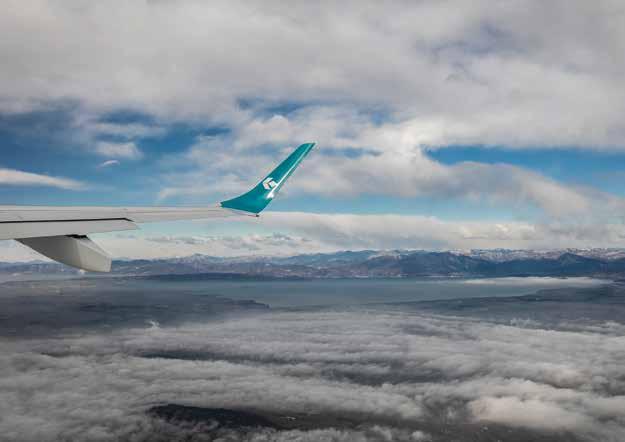
• liquids must be in containers with maximum capacity of 100 millilitres each (1/10 litre) or equivalent;
• all containers must be carried in a transparent, re-sealable plastic bag with a maximum capacity of one litre (e.g. a bag with dimensions cm 18 x 20);
• only one bag per passengers (included infant) is permitted; medication and special foodstuffs needed during the flight can be carried outside the plastic bag. However they must still be checked at the security point;
• duty-free articles purchased in a European airport or on board an aircraft registered in the EU may be carried on board inside a special bag that must be sealed by the dutyfree shop staff.
To ensure smooth checkpoint procedures passengers are required to:
• present all liquids at the checkpoint for examination;
• remove laptop computers and large electrical devices from hand baggage for security screening.
Vi auguriamo un piacevole volo!
Air Dolomiti wishes you a pleasant flight!

Arbitration boards

Se viaggia privatamente, in caso di controversie relative al volo e nello specifico:
◆ negato imbarco, ritardi prolungati o cancellazione di voli
◆ distruzione, danneggiamento, smarrimento o trasporto ritardato del bagaglio
◆ violazioni di obblighi relativi al trasporto di passeggeri disabili o passeggeri con ridotta mobilità
ha il diritto di rivolgersi agli uffici di conciliazione sotto indicati.
Schlichtungsstelle Reise & Verkehr e.V.
È l’ufficio indipendente di conciliazione della Germania per il trasporto pubblico di passeggeri. Air Dolomiti è membro di Schlichtungsstelle Reise & Verkehr e.V. e pertanto desideriamo informarla che può inoltrare una richiesta di conciliazione gratuita per qualsiasi controversia, a condizione che:
◆ abbia già esposto questi problemi ad Air Dolomiti e non abbia ricevuto risposta entro due mesi;
◆ non sia soddisfatto del modo in cui il suo problema è stato affrontato o non concordi con la gestione del suo risarcimento da parte di Air Dolomiti;
◆ la sua pretesa economica vada da un minimo di 10 Euro a un massimo di 5.000 Euro;
◆ la sua controversia non sia già, o non sia stata, pendente dinanzi a un giudice o sia già stata risolta;
◆ si tratti di un viaggio privato.
Per informazioni: http://schlichtung-reise-und-verkehr.de
Sistema ODR (On-line Dispute Resolution)
È la piattaforma messa gratuitamente a disposizione dall’Unione Europea per consentire a consumatori nell’UE o in Norvegia, Islanda e Liechtenstein di risolvere le controversie senza dover andare in tribunale. Un organismo di risoluzione delle controversie è un’organizzazione imparziale che aiuta i consumatori a trovare una soluzione extragiudiziale, facendo risparmiare tempo e denaro rispetto a una causa in tribunale. La piattaforma ODR è di facile utilizzo e guida gli utenti attraverso l’intera procedura. È disponibile in tutte le lingue dell’UE e ha scadenze integrate per la risoluzione dei reclami.
Per informazioni:
www.airdolomiti.it/customer-relations

If your journey is a private one, then in the case of flight disputes such as
• denied boarding, long delays or cancellation of flights
• the destruction, damage, loss or delayed transportation of baggage, or
• breaches of duty in the transportation of disabled passengers or passengers with reduced mobility you have the right to contact an Arbitration Body.
Reise & Verkehr e.V.
Schlichtungsstelle Reise & Verkehr e.V. is Germany’s independent arbitration board for public passenger transport that oversees all carriers. Air Dolomiti is a member of Schlichtungsstelle Reise & Verkehr e.V. and we would like to inform you that there is the possibility to ask for a conciliation process free of charge if you have concerns relating to: provided that: you have already contacted Air Dolomiti about your concerns and have not received a reply within two months, or
• you are dissatisfied with the way your concern has been handled or disagree with how your claim was processed by Air Dolomiti
• your financial claim amounts to at least 10 euros and no more than 5,000 euros
• your concern is not already, or has not been, pending before a court or has been settled
• your trip is a private trip
For further information: http://schlichtungreise-und-verkehr.de

ODR (Online Dispute Resolution)
The ODR platform is an alternative dispute resolution made available by the European Union for all European Citizens and consumers of Norway, Liechtenstein and Island. The platform is user friendly and free of charge, the out of court procedure is timesaving as the request hast o be handled within given timelimits.
For further information: www.airdolomiti.eu/ customer-relations
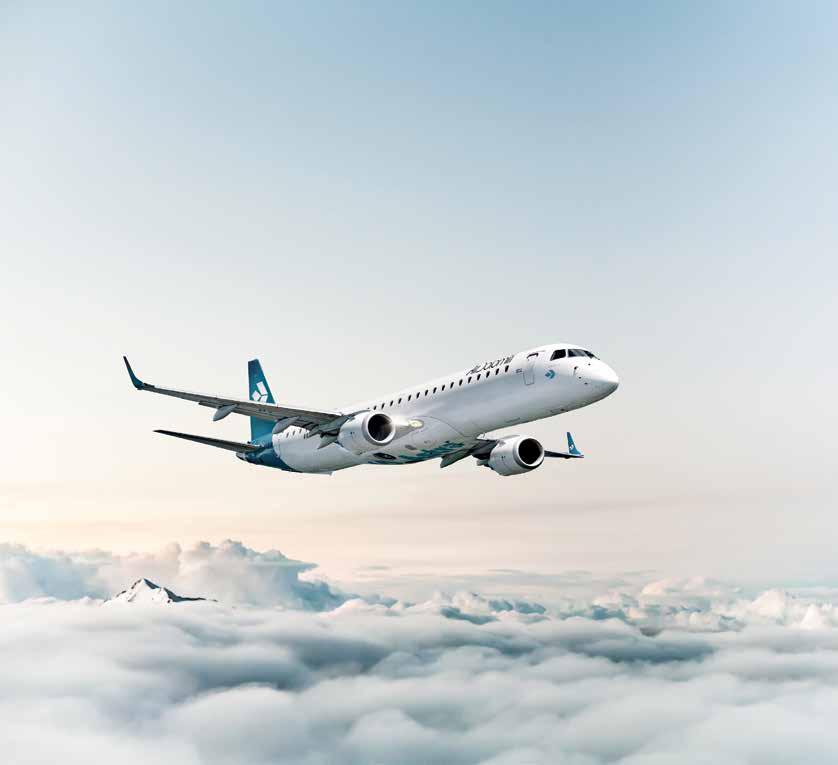
We like to make flying special. So we get you to where you’re going on time, provide gourmet catering and make sure our service always goes the extra mile. Air Dolomiti style.